Table of contents
- Preamble
- Introduction
- SDR specific information
- Detailed satellite information
- Hardware requirements
- Actually receiving the satellites!
- Common issues
- Miscellaneous stuff
- Epilogue
Preamble
NOTE: NOAA POES has been permanently retired because of political reasons. They will be greatly missed. A historical version of this guide with NOAA APT can be found here. This link is permanent.
If you’re reading this, you have probably been intrigued by the lower resolution VHF imagery that you can (or even have) received yourself. Well, you’re in for a ride! The L band is relatively easy to receive thanks to commercial solutions existing for the equipment, while it’s been deprecated by most LEO satellites, it still offers a lot of interesting data; particularly geostationary satellites. This guide will cover both. You can expect resolutions of roughly 1 km/px in the majority of this band. This guide will definitively describe the reception of the L satellite band (~1.7 GHz) when it comes to weather satellites.
This guide assumes you have read the VHF guide already, won’t repeat some more basic concepts.
There will be sample imagery next to every satellite series, you can view the raw tree along with credits here. If an image doesn’t have credit, I received it myself.
Introduction
In relation to VHF:
- The L-band is harder to receive requiring some specialized equipment as well as a dish paired with some half decent craftsmanship skills.
- Offers much more interesting things including but not limited to uncompressed LEO satellite imagery, as well as full disk Earth scans.
Example processed HRPT image
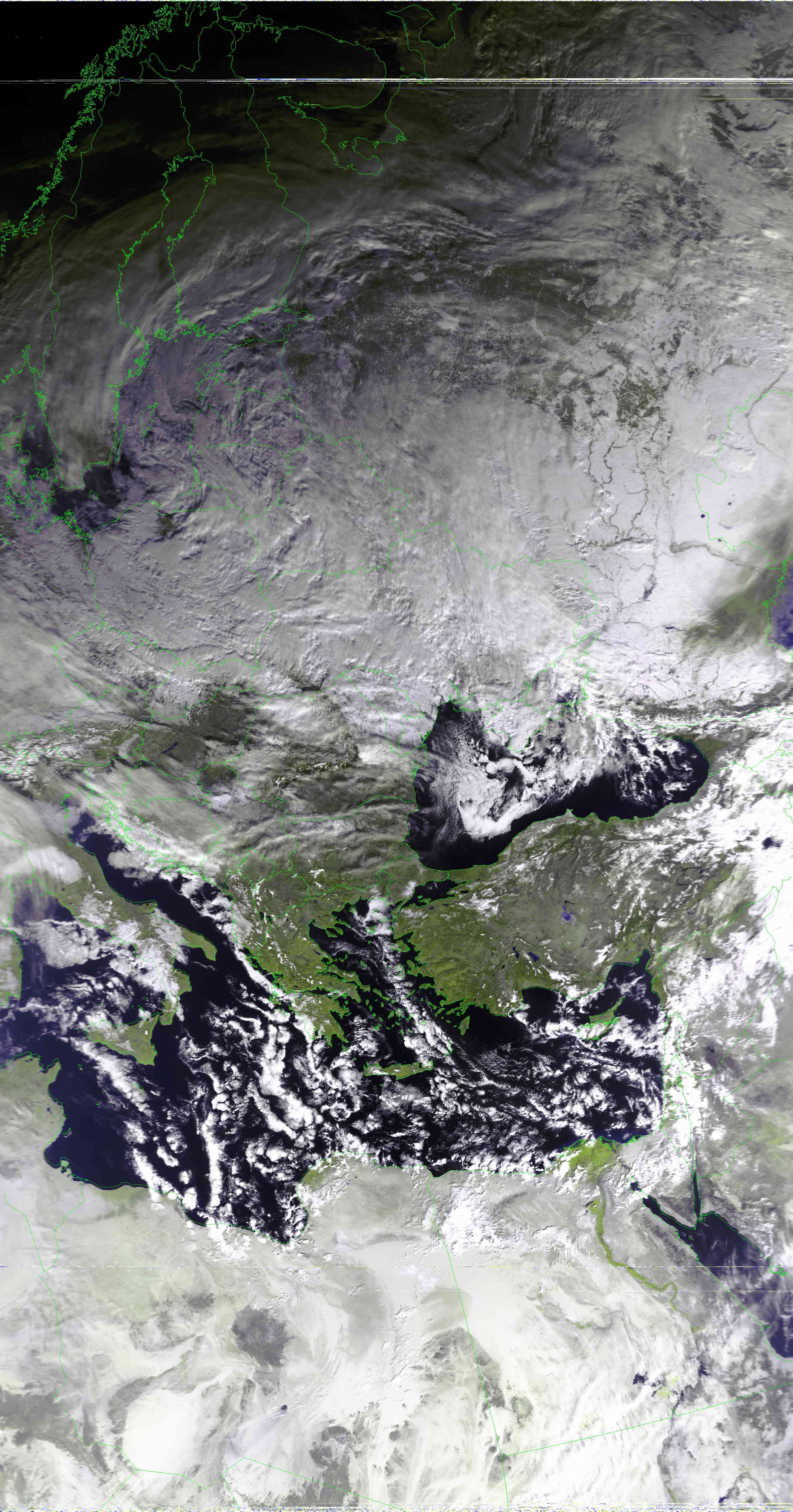 NOAA 19 received on 14/1/2024 using a 90 cm dish and a SawBird GOES+. Processed using SatDump with the
NOAA 19 received on 14/1/2024 using a 90 cm dish and a SawBird GOES+. Processed using SatDump with the NOAA Natural Color RGB composite. Median blur applied, equalized. 30% quality lossy JPEG compression with 0.05 gaussian blur applied, click here for the full resolution image.
Sample processed geostationary image
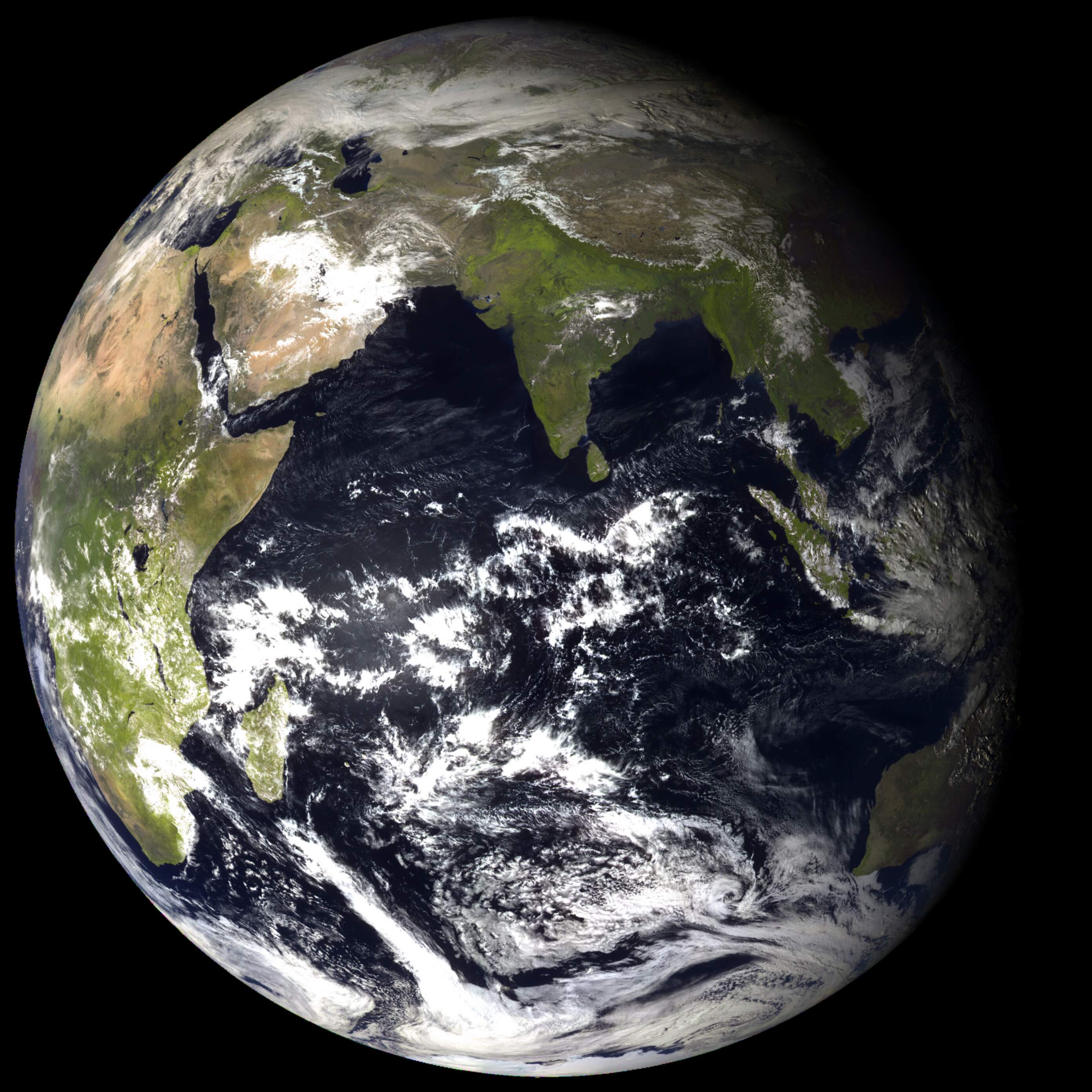 Elektro-L N3 LRIT received on 11/2/2024 using a 125 cm dish and a SawBird GOES+. Decoded using SatDump. Pictured is the autogenerated
Elektro-L N3 LRIT received on 11/2/2024 using a 125 cm dish and a SawBird GOES+. Decoded using SatDump. Pictured is the autogenerated NC (Natural Color) composite. 65% quality lossy JPEG compression with 0.05 gaussian blur applied, click here for the full resolution image.
SDR specific information
RTL-SDR
These apply to all SDRs using RTL chipsets (RTLSDR blog, Nooelec SMART…)
- The maximum stable sampling rate is 2.56 Msps! Using anything higher can lead to sample drops if you don’t have one of the few incredibly specific USB controllers with which the RTL chipset can pull 3.2 Msps without dropping samples. You can test if higher sampling rates such as 2.88 Msps work on your setup by running
rtl_test -s 2.88e6and seeing if any data is lost after a few minutes, or decoding a signal with FEC (Such as LRPT) near the edge of your spectrum and seeing if there are any spikes on the viterbi graph. Android devices can usually handle 2.88 Msps without dropping samples.Please note, that on some devices even 2.56 Msps drops samples! Run
rtl_test -s 2.56e6to test, or receive signals with error correction and see if the viterbi graph has spikes (indicative of sample drops). - RTL-SDR Blog V4 needs specific drivers to work with most software, the installation steps are described on their quick start page
- Nooelec Smart SDR v5 also needs specific drivers to work with most software, the installation steps are described on their quick start page
HackRF One
- DO NOT USE THE
Amp(preamplifier) OPTION!!! The preamplifier is flawed, can get killed very easily. An exception to this is when you’re using Clifford Heath’s redesign, which adds several protections making the preamplifier safe to use. - The HackRF has a fairly outdated design which suffers from heavy phase noise. This means, that you have to receive signals stronger than other SDRs to achieve the same quality.
- This SDR has a nasty DC spike in the middle. If dealing with thin signals, an offset of at least 50 kHz is recommended
- (Have to confirm, take with a grain of salt!) The HackRF has a frequency shift of 30 kHz. This is negligible in 99% of cases, but if dealing with signals that have very low symbol rates, you might have to tune 30 kHz above an already offset frequency to get a lock.
Using an offset for very narrow signals is generally recommended because of the last two points, shifting +130 kHz should both problems.
MiriSDR (MSI.SDR)
- The only version that doesn’t have gaps in the L satellite band is a thin board with DIP switches. However, these DIP switches make the SDR quite deaf, requiring an additional amplifier just before the input to achieve decent results. This can be remedied by removing the DIP switches and directly soldering a wire between the RF input and the L frequency band.
Detailed satellite information
Low-Earth-Orbiting satellites
- There are 5 LEO satellites currently broadcasting imagery in this band:
- 2x Meteor-M
- 2x MetOp
- 1x AWS
METEOR-M
- 2 satellites from this constellation currently broadcast in this band: Meteor M2-3 and Meteor M2-4
- Have a Meteor HRPT broadcast containing 6 MSU-MR channels in addition to 30 MTVZA channels.
- This broadcast features a very strong carrier wave making it easy to track.
- Full resolution sample imagery:
Meteor-M N°2-2 is currently in storage mode due to its orbital proximity to M2-4. It can be reenabled if an issue arises with M2-4.
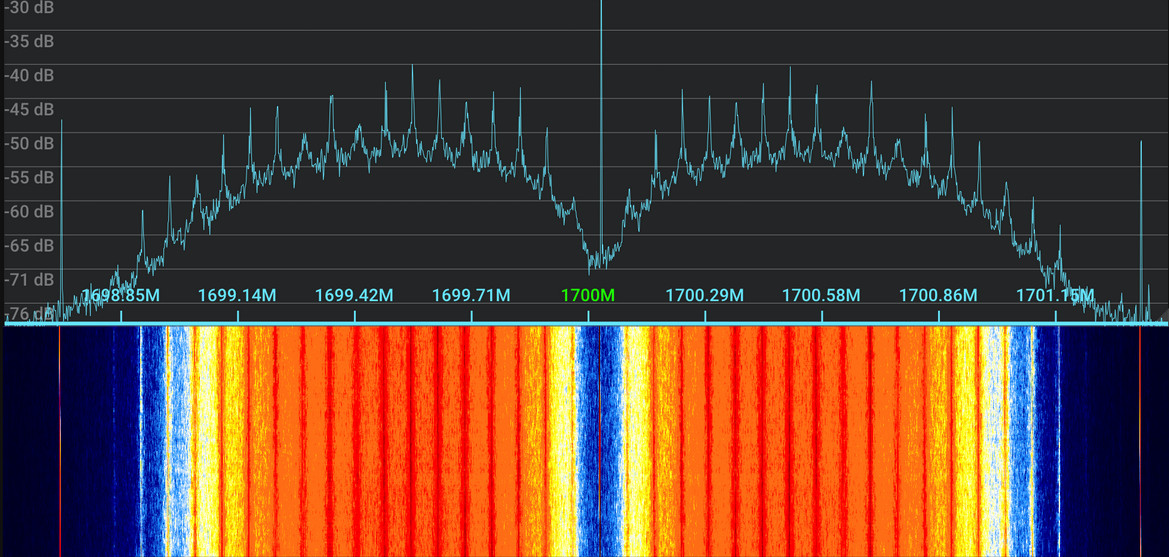
Meteor-M N°2-2 HRPT
MetOp
- There are two functional satellites: MetOp-B and MetOp-C operated by EumetSat, launched in 2013 and 2019 respectively.
- Have a MetOp AHRPT (Advanced High Rate Picture Transmission) broadcast which - unlike METEOR-M HRPT - includes Reed-Solomon FEC to make sure your picture doesn’t come out with grain. The broadcast also contains several more instruments and much more data, including 5 AVHRR channels at a 1.1 km/px quality as well as one IASI Imaging channel at 0.8 km/px.
- The signal does not have a carrier wave or easily discernible bumps making it a bit harder to track, it presents as a jumpy signal on the FFT.
Reception note: When receiving with an RTLSDR, you might run into some issues owing to its relatively high symbol rate. If you get a donut shaped constellation while decoding this signal, make sure to follow this heading
- Full resolution sample imagery:
!NOTE! - Since 03/2025, MetOp B was found to have a deteriorating modulator intermittently causing a significant hit to its SNR. According to receptions by Lego11 and Aang23, there was an approximately 7 dB loss compared to the nominal status. This issue is visible when decoding at higher SNRs, where the modulator starts to form an X shape instead of the correct OQPSK modulation.
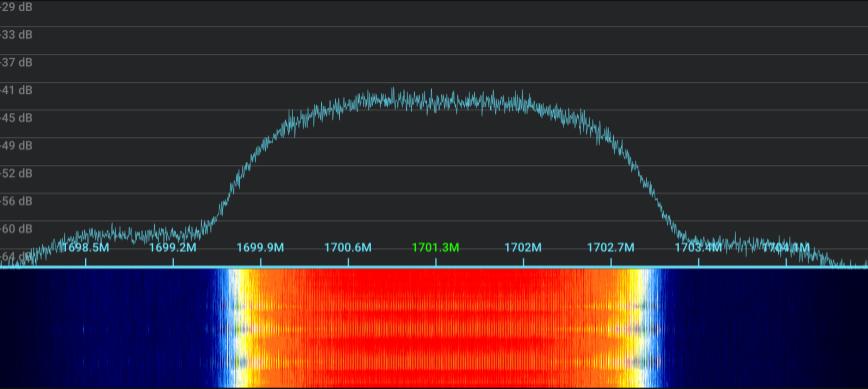
MetOp-B AHRPT
Arctic Weather Satellite
- Arctic Weather Satellite (AWS for short) is a prototype satellite that launched very recently - 08/2024, broadcasts imagery at a 10-40 km/px quality, depending on the channel.
- Broadcasts a 24/7 DB signal, dumps full orbit imagery to Svalbard.
- Is a prototype to EPS-STERNA, which is scheduled to be a satellite constellation that fills the gap in Geostationary satellite data present at the poles. These satellites are expected to launch in 2029, have the same imaging instrument as AWS.
Reception note: The satellite antenna seems to have an inconsistent radiation pattern causing the signal to significantly fluctuate when heading away from you.
- Full resolution sample imagery:
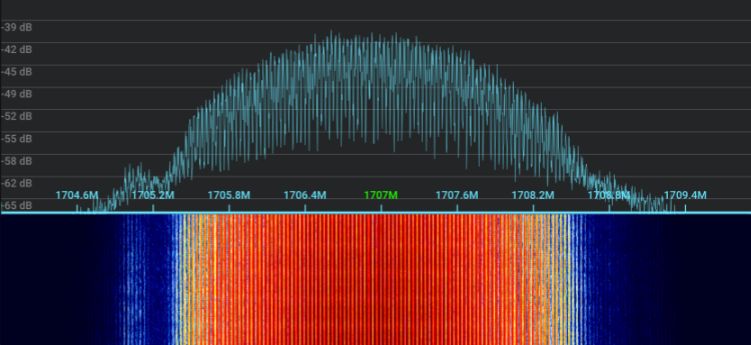
AWS PFM while in Direct Broadcast mode
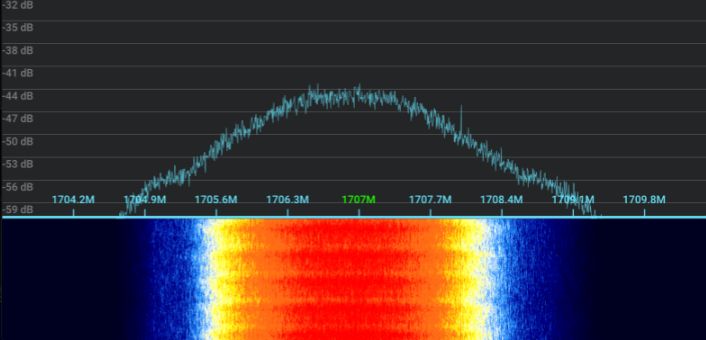
AWS PFM while dumping
NOAA POES (DEAD)
- NOAA POES used to transmit HRPT 1978-2025 before being decommissioned. There are no future launches. A historical version of the guide with POES can be found here
- Sample imagery will be kept here for historical purposes
- Full resolution sample imagery:
Fun fact: Since 2021, NOAA 2 (ITOS-D) - A 50-year-old satellite! - has gone back to life transmitting a legacy ITOS HRPT broadcast. It includes no actual imagery since the VHRR sensor has died ages ago, however it still matches the modulation and spec - if decoded properly you can still see the familiar sync lines from APT broadcasts.
FengYun 3C (DEAD)
- In a statement from NSMC, the satellite has FAILED as of 11/2024. The satellite used to transmit true color imagery when in sight of Chinese territory.
- Sample imagery will be kept here for historical purposes
- Full resolution sample imagery:
Frequency reference
| Satellite | Frequency |
|---|---|
| Meteor M2-3, M2-4 | 1700 MHz |
| MetOp B, C | 1701.3 MHz |
| Arctic Weather Satellite | 1707 MHz |
Geostationary satellites
- Receiving these is arguably even easier than LEO satellites, since the only limiting factors are line of sight and dish size
- Don’t require tracking, since the satellites don’t move (It’s on the tin - geostationary)*
- Broadcast full disc images of the earth and/or regional crops
* Some older satellites might have an increased inclination, where they slowly move in an 8 shape throughout a day. They still maintain a consistent longitude though.
- There are 13 geostationary satellites broadcasting imagery in this band:
- 2x GOES in the US
- 1x EWS-G in Europe and Asia (Retired GOES)
- 2x Elektro-L in Europe, Asia and Oceania
- 4x FengYun in Asia and Oceania
- 1x Geo-Kompsat in Asia and Oceania
- 3x MSG in Europe
GOES
- GOES 18 and GOES 19, satellites from the
GOES-Rseries, are the two currently operational satellites broadcasting three signals:- CDA Telemetry - Contains telemetry (duh), can be used to check your setup is working properly.
- HRIT - A strong and very easy to receive signal transmitting imagery at 2 km/px, as well as rebroadcasted data from other satellites such as Meteosat and Himawari
- GRB - A fairly weak rebroadcast sending full quality data from the majority of instruments, has a massive 7.8 Msym/s. Transmits half the data over RHCP and the other half over LHCP.
-
All of these include FEC, meaning you should be able to properly decode them even when the signal is quite weak. HRIT has notably good FEC, able to get clean imagery even out of just 1 dB!
- HRIT transmits:
- Full disk Earth: 1x VIS + 6x IR at 2 km/px every 30 minutes
- Mesoscale crops: 1x VIS + 2x IR at 2 km/px every 15 minutes
- The other operational GOES 1x IR at 4 km/px every hour
- Himawari: 1x VIS, 1x IR, 1x WV at 4 km/px every hour
- Meteosat: 1x IR at 15 km/px every hour*
- Miscellaneous EMWIN data (Crops, weather charts, L2 products…)
* I’ve only seen this in GOES-East HRIT. Additionally, the imagery is in EMWIN, not IMAGES.
- GRB specifically transmits:
- LHCP:
- ABI channels 2,7,8,10,14,15,16*
- RHCP:
- ABI channels 1,3,4,5,6,9,11,12,13
- Goes lightning mapper
- SUVI imagery
- SEM (Solar flux, magnetometer)
- LHCP:
* All channels except 10 and 16 are also transmitted via HRIT - getting the LHCP broadcast is pretty much pointless.
- Full resolution sample imagery (Credit to Patrick Cunningham):
- HRIT:
- Full disk:
- Mesoscale:
- Other data:
- Retransmitted other GOES (GOES 18 retransmitted from GOES 19 HRIT)
- Himawari (click on a file to view it)
- MSG
- GRB:
- RHCP - Credit to Aang23:
- HRIT:
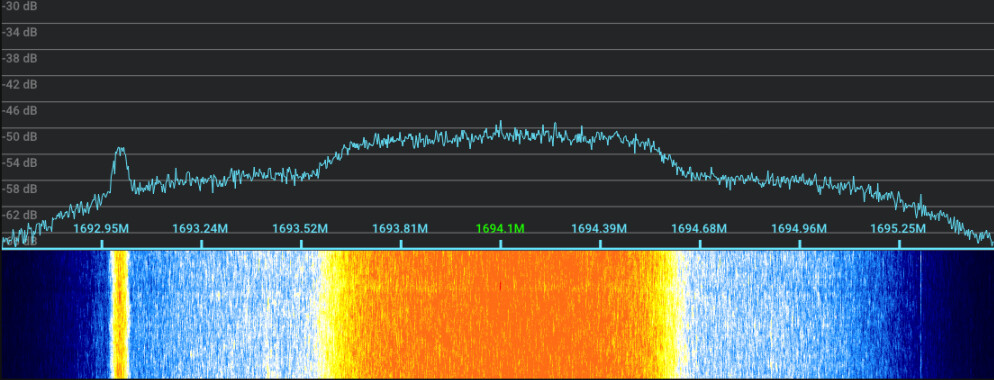
GOES 18 CDA Telemetry on the left, HRIT in the middle. Credit: phantomsghost on Discord
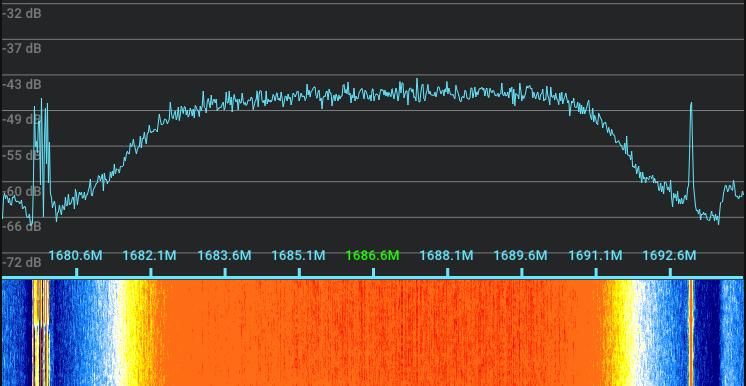
GOES 18 GRB, spike on the left is DCP and spike on the right is CDA telemetry.
GOES 14, 16, 17 are currently in on-orbit storage and are not broadcasting anything useful.
EWS-G
- EWS-G2 (GOES 15), a retired GOES satellite part of the
GOES-Nseries, was transferred to USSF and moved over the Indian Ocean to replace EWS-G1 (GOES 13) and now broadcasts a few relatively weak signals:- CDA Telemetry - Contains telemetry (duh), can be used to check your setup is working properly
- GVAR - A relatively weak broadcast that contains all 5 imagery channels at a 1 km/px quality for the singular VIS channel and 4 km/px for the other IR channels.
- SD - Sensor Data - Broadcasts raw instrument data, separates into two downlinks on the same frequency:
- Raw imager data
- Raw sounder data
- GVAR is very prone to corruption because of lacking FEC, which often causes lines to be misplaced in the resulting imagery. In 2.0, correction has been baked in, but if you are still using an older version of SatDump and want significantly more presentable imagery at low SNRs, you can find it here.
- The sounder is disabled: The raw sounder downlink is empty, GVAR produces empty sounder images. The solar imager (SXI) is also disabled.
Reception note: The satellite normally does regional crops, as they can be scanned faster than full disc images at just 15 minutes. It still transmits a full disc image every 3 hours.
- Full resolution sample imagery:
- Raw channel 1 - No noise, credit to that_zbychu)
- False Color
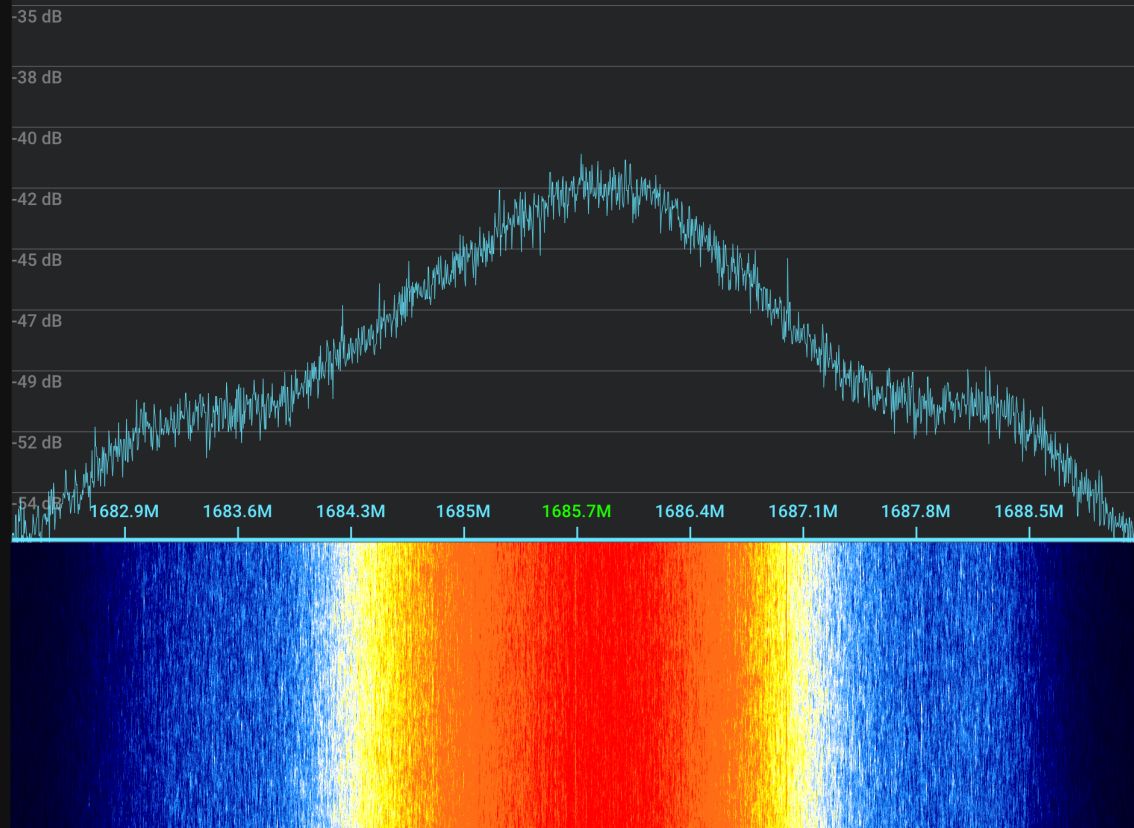
EWS-G2 (GOES 15) GVAR
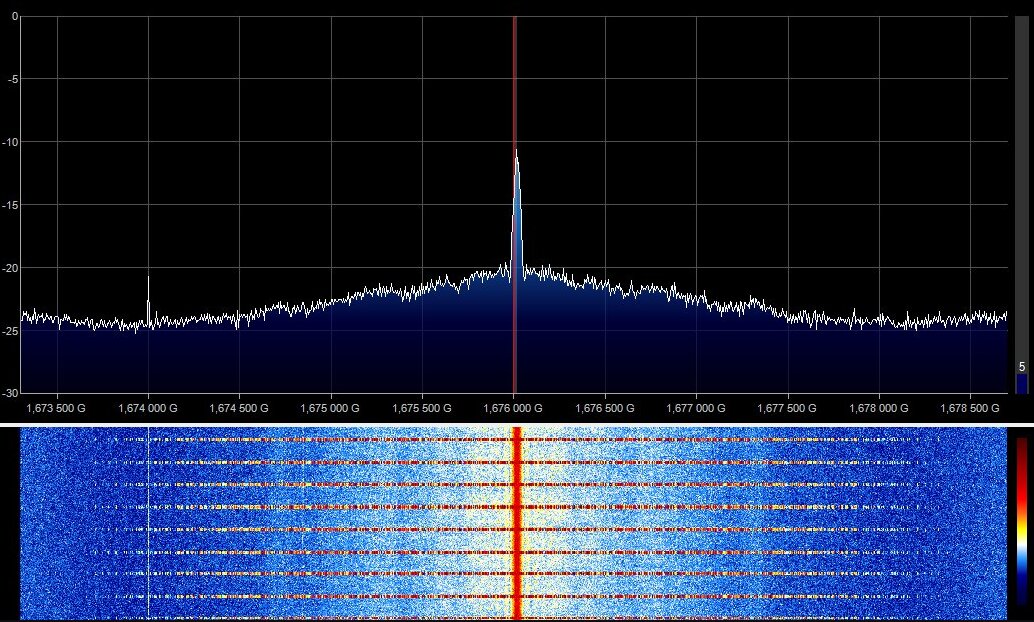
GOES 13 SD: sounder SD is the thin spike in the middle, everything else is the imager SD. Credit: dereksgc on Discord
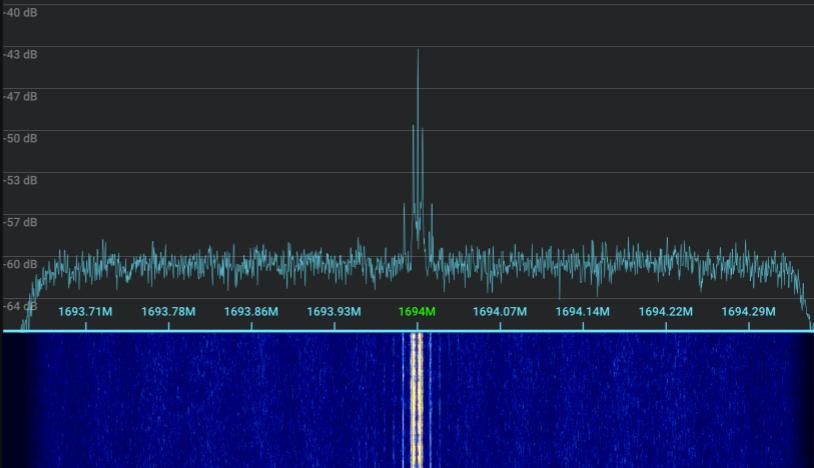
EWS-G2 (GOES 15) CDA
Elektro-L
- Elektro-L N°3 and Elektro-L N°4 (Elektro-L# for short) are the two satellites from the Elektro-L series broadcasting imagery in the L-band. Due to a fairly recent power supply failure, Elektro-L2 only broadcasts a beamed X-band transmission to Moscow.
- They broadcast Low Rate Information Transmission (LRIT) as well as High Rate Information Transmission (HRIT) signals containing full disc images of the earth at a 4 km/px quality. Both of these include Reed-Solomon FEC, meaning you can get clear imagery at just ~2.5 dB.
- LRIT broadcasts any number of channels, for Elektro-L3 it’s 3 visible channels, one water vapor channel (degraded), as well as one infrared channel. L4 broadcasts channels too inconsistently to be specified here.
- These satellites have recently began transmitting at 06:XXZ, something they haven’t done for years. It is unknown whether this time slot will remain enabled, but as of the latest commit; both satellites transmit it. 18:XXZ still hasn’t returned, but should come back by May.
- All Elektro (as well as Arktika) data is available on the NTSoMZ FTP:
ftp://electro:electro@ntsomz.gptl.ru:2121/ - Elektro-L N°5 is scheduled for launch on 12/2025, will replace L3 which will in turn be moved over to 14.5°W, replacing L2. L2 will be decommissioned due to existing issues with power and imaging instrumentation. This will be the first time that Europe has accessible xRIT in a few years.
- The 06:XX and 18:XX time slots are seasonal, both should be active during summer and winter months
Reception notes:
- LRIT:
- LRIT broadcasts pre-equalized channels, which often end up severely over-exposing the imagery. The reason why imagery is broadcasted like this is a bit complex.
- After a few minutes of LRIT from Elektro-L3, you will be able to notice a spiky signal appear at 1690.5 MHz, this is linearly polarized dead LRIT from the neighboring satellite FengYun 2H. It might interfere with Elektro LRIT reception, in which case you should point slightly farther from 2H.
- Elektro-L4 has broadcast issues; the LRIT broadcast consistently cuts off after 15 minutes, even when in the middle of transmitting an image.
- GGAK:
- You can use GGAK as a 24/7 metric to see if you should be capable of decoding xRIT: 10 dB on GGAK should equal to about 2.5 dB on LRIT (enough for a decode), 17 dB on GGAK should equal to about 3 dB on HRIT (enough for a decode).
- GGAK gets significantly weaker while an xRIT transmission is in progress.
- Elektro-L2 also transmits GGAK, but the strength seems inconsistent when compared to its contemporaries. It used to be a tad weaker, now it appears to be significantly stronger.
- GGAK has a very low symbol rate, you might have difficulties getting the pipeline to lock. If you have trouble doing so:
- Your SDR likely has a small reference inaccuracy, decimate and tune until the GGAK signal is centered. Add this offset to the next steps.
- Set frequency offset to 50 kHz + the reference inaccuracy (Explained above) if your SDR has one, shift that much above 1693 MHz
- Start the pipeline
- If you don’t sync, look at the
Frequencyvalue, it will likely be pinned at +3 kHz or -3 kHz. Shift 3 kHz lower or higher respectively, it should lock thereafter.- If you still can’t sync, try setting the pll bandwidth to 0.002 [#pll-bw]
- Full resolution sample imagery:
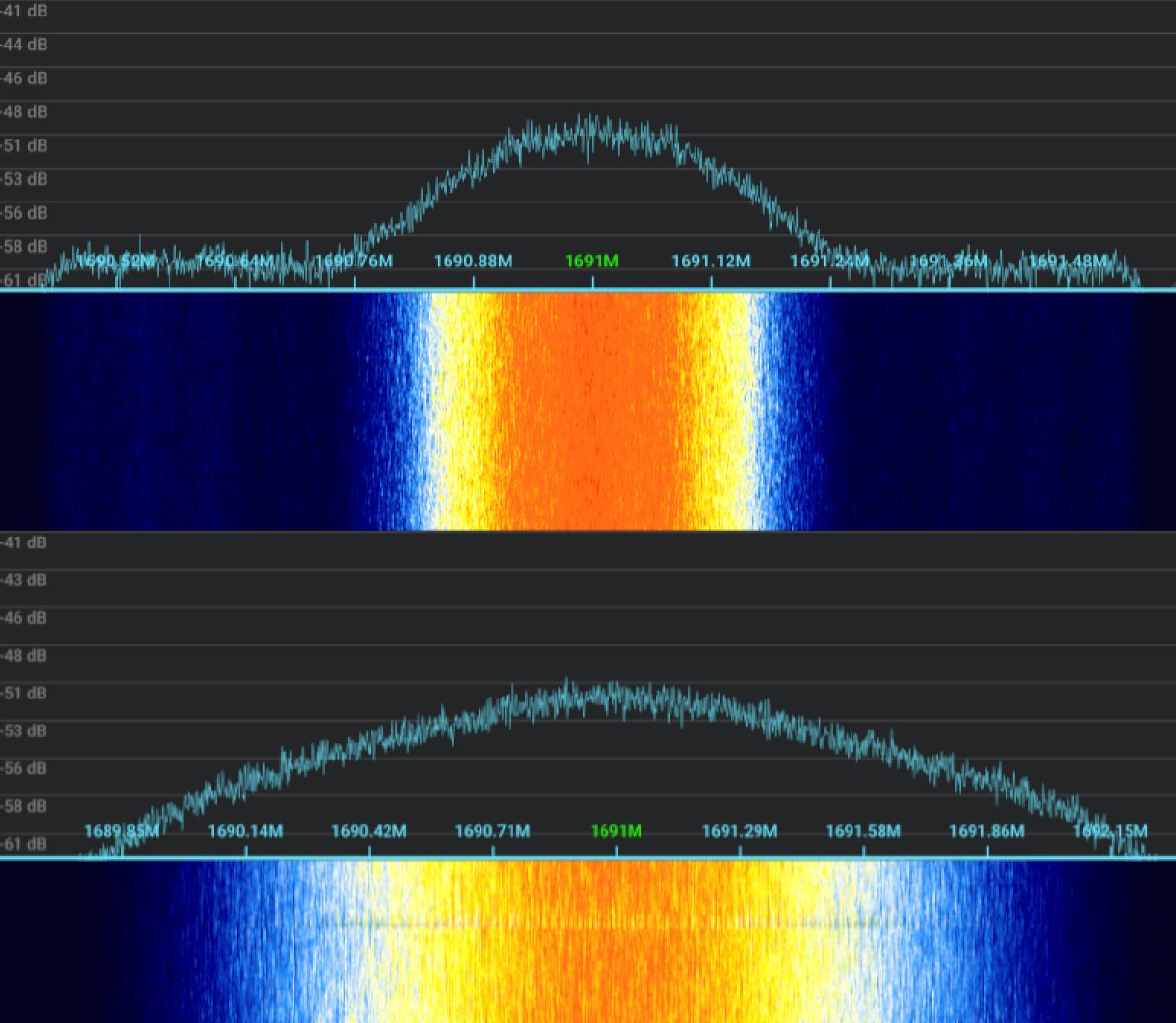 Elektro-L N°3 LRIT on the top, HRIT on the bottom
Elektro-L N°3 LRIT on the top, HRIT on the bottom
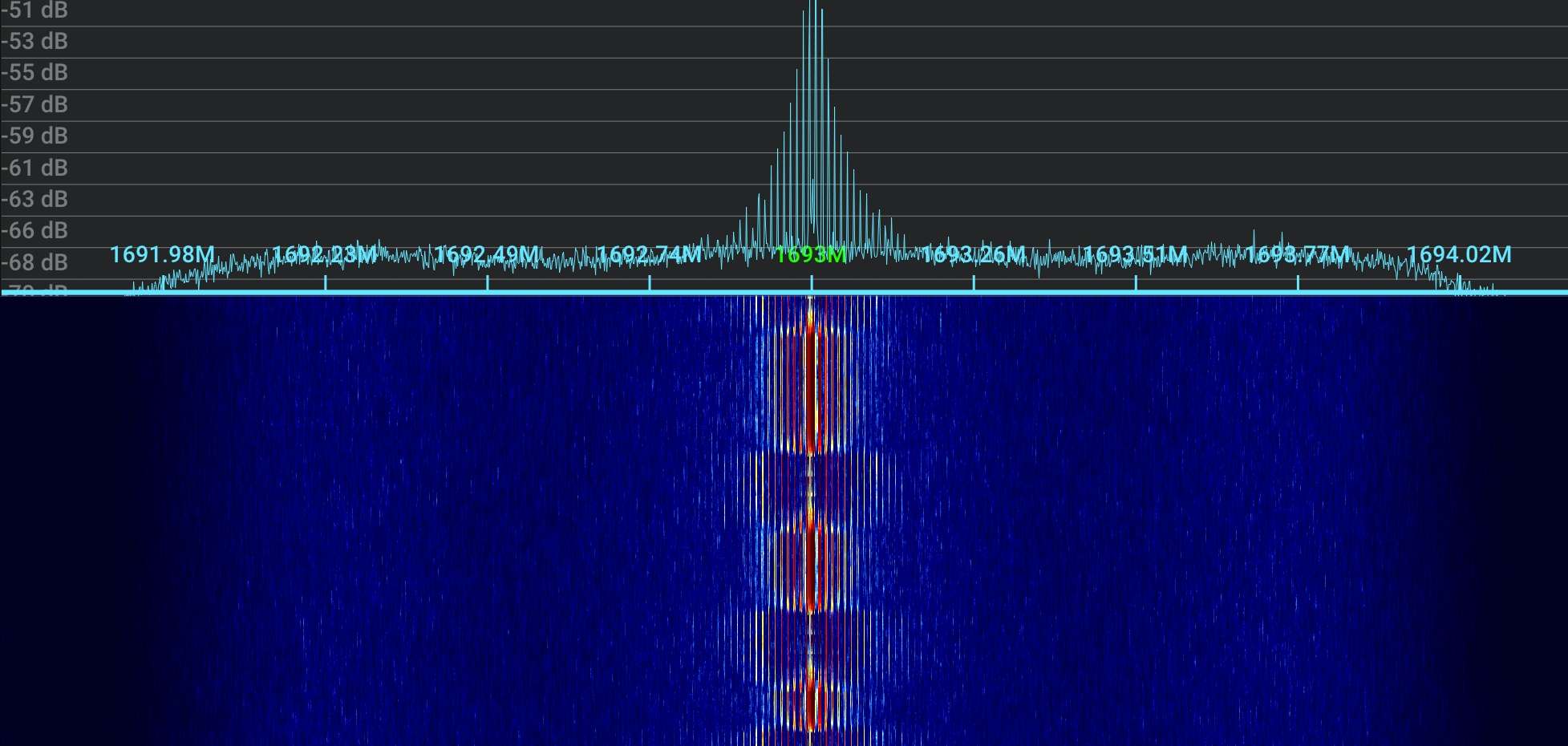 Elektro-L N°3 GGAK
Elektro-L N°3 GGAK
FengYun
FengYun 2 series
- FengYun 2H, and FengYun 2G broadcast a linearly polarized S-VISSR signal containing 5 channels (1 visible, 4 infrared) at a fairly high quality - 1.25 km/px for the singular VIS channel and 5 km/px for the 4 IR channels.
- This signal is very prone to corruption because of lacking FEC, which often causes misplaced/missing lines. You can use HRPTEgor’s S-VISSR corrector instead of the default
FengYun 2 S-VISSRpipeline to remedy this. - FengYun 2H broadcasts dead (empty) LRIT every hour (except 5:30Z and every 6 hours onwards) on 1690.5 MHz, this leads to the second image being cut at about 57%.
- During the eclipse season (near equinoxes), these satellites lose track of the sun and end up not transmitting any imagery 17:00Z-19-00Z. The transmission might be off, or a jumpy S-VISSR signal with no data might be present instead.
Reception note: FengYun 2H has been experiencing issues with the power amplifier, causing significant fluctuations in SNR. Usually they clear up in a few minutes, but the broadcast strength end up being below nominal for a while after.
These satellites also broadcast an incredibly weak CDAS raw downlink, but it’s almost completely undocumented owing to its weak & wide nature. It is present just left S-VISSR, the satellite uses the same transmitter as S-VISSR to transmit it albeit at a significantly higher symbol rate to instantly transmit the whole scan line in real time. This is the reason why S-VISSR is so jumpy.
- Full resolution sample imagery:
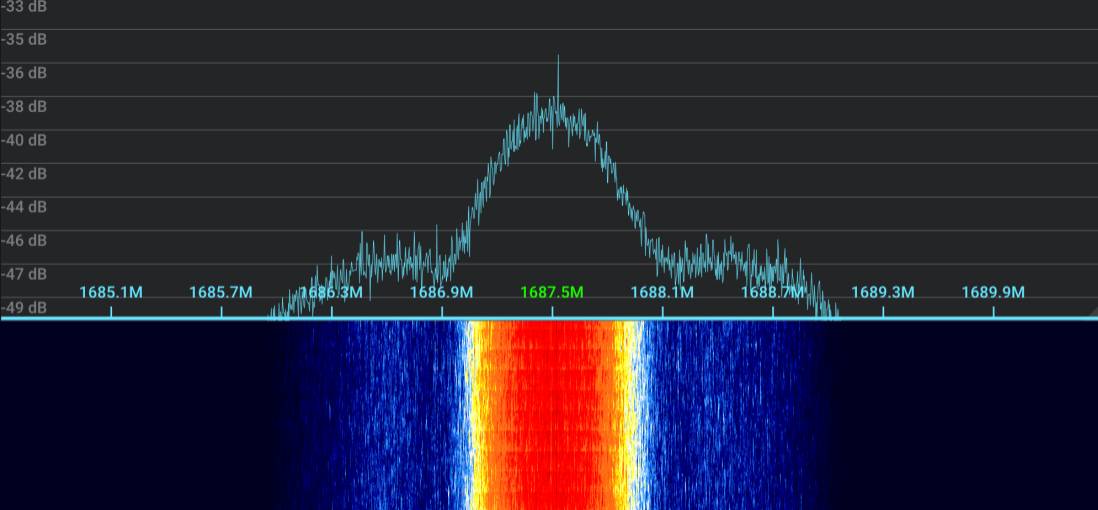
FengYun 2H S-VISSR
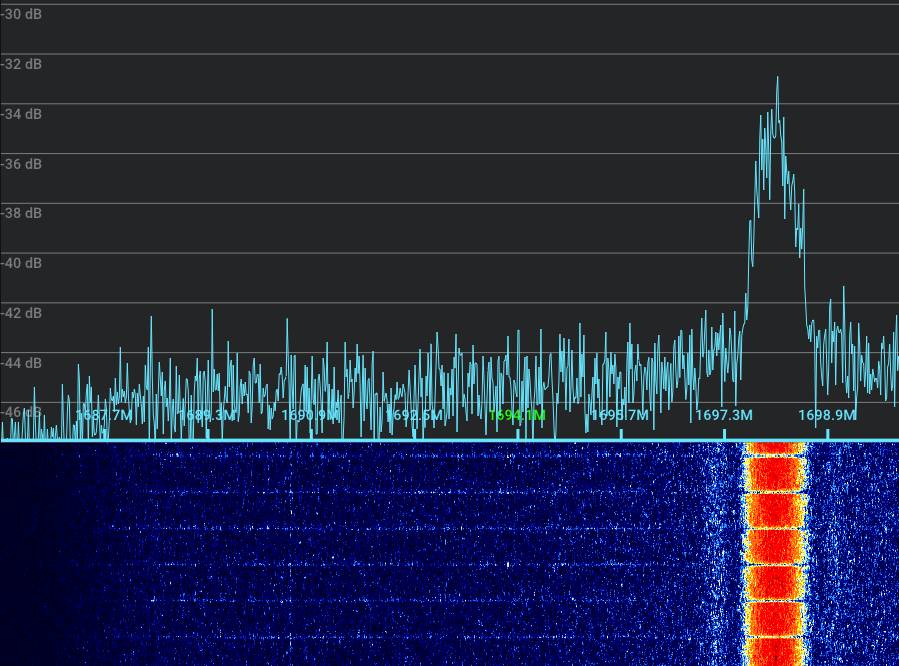
FengYun 2H CDAS. See how the blips line up with the gaps in S-VISSR. Thin spikes throughout spectrum are not a part of the signal. Credit: digielektro on Discord
FengYun 4 series
! WARNING ! - I can’t confirm the status of either of these, if you have any information about it please let me know using the contacts at the bottom of this page. The satellites seem to intermittently cease broadcasts, rarely transmit any imagery.
Latest updates:
- 10/1/2025: No visible broadcast from FengYun 4B
- 15/04/2025: LRIT without imagery enabled on FengYun 4A, HRIT not checked
- FengYun 4A and FengYun 4B currently broadcast a linearly polarized LRIT and HRIT signals. The LRIT signal only broadcasts at a very poor quality (Have to confirm, but less than 4 km/px), HRIT only transmits a single unencrypted infrared channel.
-
This satellite series has been shrouded in mystery, with both satellites having transmitted xRIT in the past albeit without any live imagery. These broadcasts have intermittently stopped without any acknowledgement from NSMC (Satellite operators).
- Full resolution sample imagery:
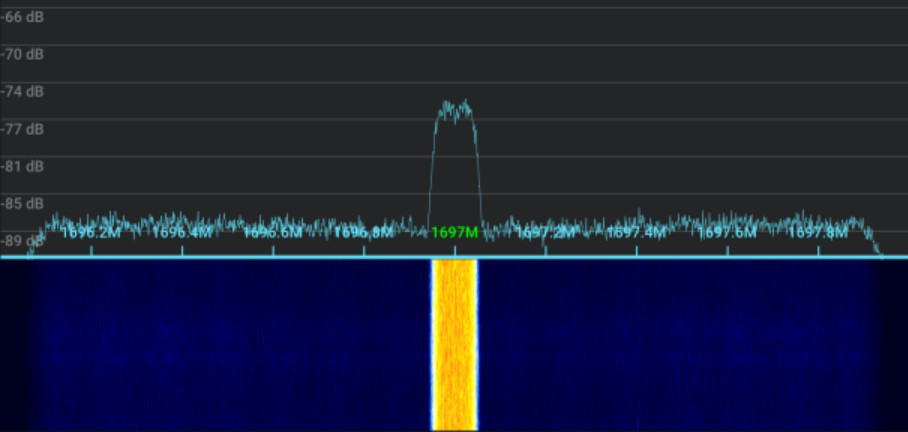
FengYun 4A LRIT, Credit: drew0781 on Discord
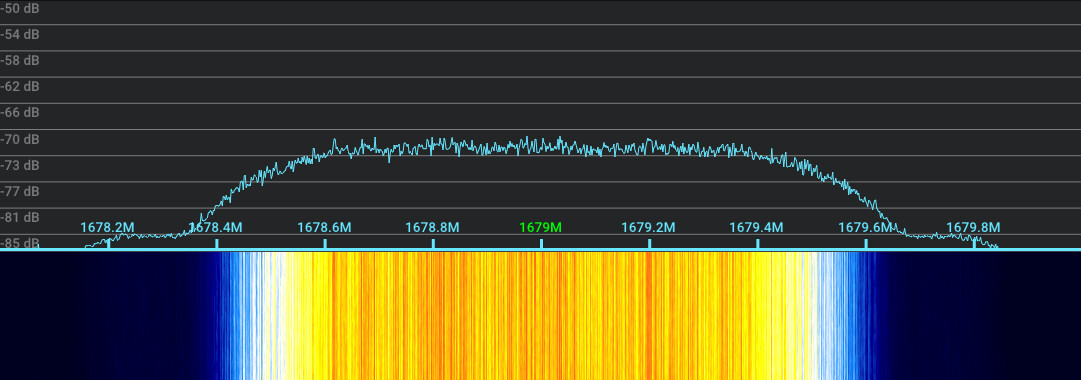
FengYun 4A HRIT, Credit: drew0781 on Discord
GEO-KOMPSAT
- GEO-KOMPSAT-2A currently broadcasts LRIT and HRIT at a 4 and 1 km/px peak quality respectively. The broadcasts are encrypted, but the decryption key has been shared by the operators, making amateur reception possible.
- LRIT is notorious for being extremely strong, not even requiring a dish to decode an image.
- LRIT transmits miscellaneous data in addition to a 4 km/px IR channel every 10 minutes
-
HRIT transmits 1x 1 km/px VIS, 3x 4 km/px IR, 1x 4 km/px water vapor every 10 minutes
- Full resolution sample imagery:
- HRIT
- LRIT
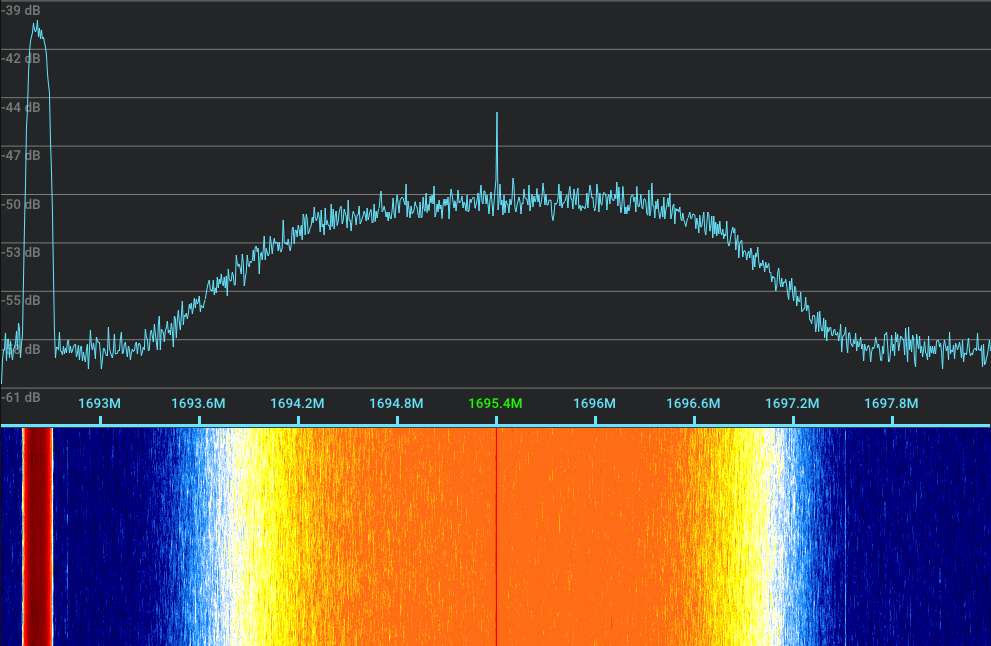
GEO-KOMPSAT-2A LRIT on the left, HRIT in the middle
Meteosat Second Generation (MSG)
- Meteosat 9, 10, and 11 broadcast a notoriously weak linearly polarized PGS raw data downlink containing all of their channels - 1x panchromatic at 1.6 km/px, 3x VIS and 9x IR at a 4.8 km/px quality (Sensor can do 1 km/px and 3 km/px respectively but the instrument as a whole oversamples 1.6x to get a better dynamic range)
- This is the second weakest geostationary L-band signal behind FengYun 2 CDAS, requiring approximately a massive 4-meter dish to decode.
Few people have access to such dish sizes in Europe, I personally only know of 3 people ever receiving it, all with custom amplifiers. The 4-meter estimate stems from @Digielektro using a 3-meter dish and a custom amplifier for a decode.
-
The imaging insturment, SEVIRI, has a panchromatic channel called HRV (High Resolution Visible) which transmits a crop of Europe and a crop of the bottom hemisphere every 15 minutes, these move with sunlight as pictured below

HRV crops, source - SEVIRI has two operating modes:
- RSS - Rapid Scan Service - The top third of the Earth is transmitted every 5 minutes
- FES - Full Earth Scan - The whole earth is scanned every 15 minutes
- Full resolution sample imagery (credit to FelixTRG):
- 321
- 221
- Day Microphysics - Misaligned channels, ‘blur’ effect
- Water Vapor
Reception note: The minimal dish size is speculative due to insufficient data, I do not know of anybody receiving it with just a SawBird. The 4-meter dish size given is a rough estimate.
These satellites used to transmit a much stronger LRIT signal which contained five channels along with rebroadcasted GOES data, but the broadcast was discontinued in 2018.
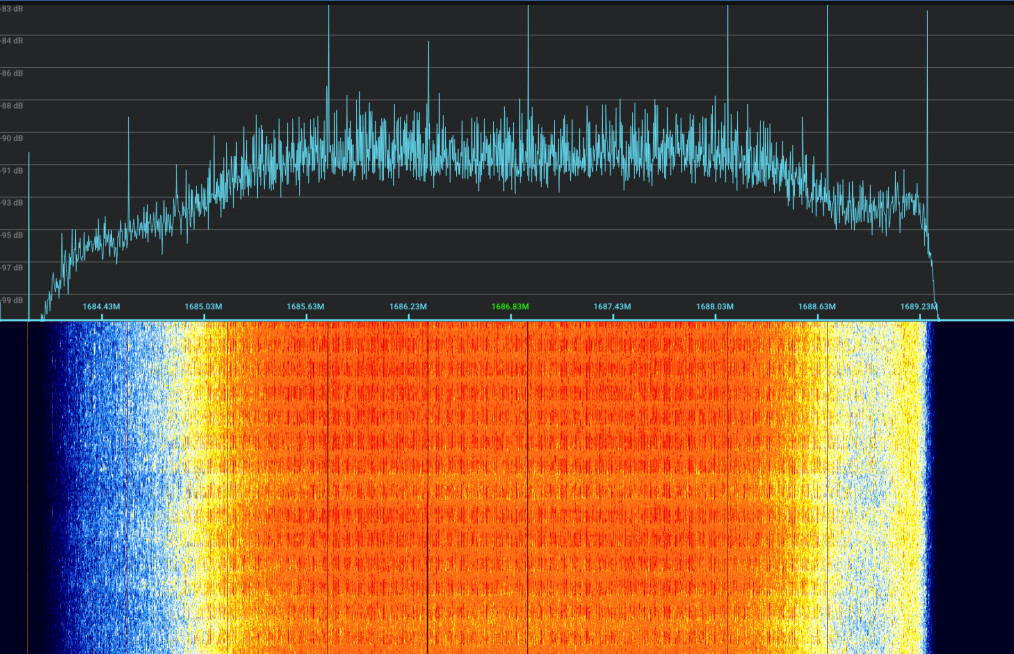 Meteosat 9 PGS, Credit: that_zbychu on Discord. The thin spikes present aren’t a part of the signal.
Meteosat 9 PGS, Credit: that_zbychu on Discord. The thin spikes present aren’t a part of the signal.
Signal information
Low-earth-orbiting
All signals listed below are RHCP!
| Signal | Minimum dish size | Symbol rate | FEC | Notes |
|---|---|---|---|---|
| Meteor HRPT | 60 | 665.6 ksym/s* | No | |
| MetOp AHRPT | 60 | 2.33 Msym/s | Yes | Just barely receivable with an RTLSDR, might cause issues |
| AWS PFM | 60 | 1.785 Msym/s | Yes | Fades when facing away |
* Parallel modulated signals - Two 665.6 ksym/s bumps. SatDump receives both, a sampling rate of at roughly 2.4 Msps is recommended.
Geostationary
- The minimum dish size heavily depends on the satellite’s elevation! You might be able to get it with a smaller dish if the satellite is high up, or need a bigger dish if it’s low in the sky (~ <15°)
- The minimum dish size stated is when considering an optimal feed setup and a SawBird GOES unless stated otherwise.
| Satellite series | Signal | Frequency | Symbol rate | Polarization | Minimum dish size | FEC | Transmits… |
|---|---|---|---|---|---|---|---|
| Elektro-L | LRIT | 1691 MHz | 294 ksym/s | RHCP | 60 cm | Yes | Every 3 hours from midnight UTC at XX:42 |
| Elektro-L | HRIT | 1691 MHz | 1.15 Msym/s | RHCP | 100 cm | Yes | Every 3 hours from midnight UTC at XX:12 |
| Elektro-L | GGAK | 1693 MHz | 5 ksym/s | RHCP | None | N/A | Constantly, can be used to verify your setup is functional |
| GOES-R | CDA Telemetry | 1693 MHz | 40 ksym/s | Linear | N/A | Yes | Constantly, can be used to verify your setup is functional |
| GOES-R | HRIT | 1694.1 MHz | 927 ksym/s | Linear | 80 cm | Yes | Constantly, image every 15 minutes |
| GOES-R | GRB | 1681.6 MHz | 8.67 Msym/s | LHCP+RHCP | 180 cm | Yes | Constantly |
| EWS-G | CDA Telemetry | 1694 MHz | 40 ksym/s | Linear | N/A | Yes | Constantly, can be used to verify your setup is functional |
| EWS-G | GVAR | 1685.7 MHz | 2.11 Msym/s | Linear | 100 cm* | No | Full disc image at midnight UTC, every 3 hours onwards. Regional crops every 15 minutes rest of the time. |
| EWS-G | Imager SD | 1676 MHz | 2.62 Msym/s | Linear | 300 cm | No | Constantly |
| EWS-G | Sounder SD | 1676 MHz | 40 ksym/s | Linear | 125 cm | No | Constantly |
| FengYun 2 | S-VISSR | 1687.5 MHz | 660 ksym/s | Linear | 60 cm* | No | XX:00 - XX:28, second time slot variable** |
| FengYun 4 | LRIT | 1697 MHz | 90 ksym/s | Linear | 60 cm | Yes | Hourly |
| FengYun 4 | HRIT | 1681 MHz | 1 Msym/s | Linear | 150 cm | Yes | Every half an hour |
| GEO-KOMPSAT | LRIT | 1692.14 MHz | 128 ksym/s | Linear | None*** | Yes | Constantly, image every 10 minutes |
| GEO-KOMPSAT | HRIT | 1695.4 MHz | 3 Msym/s | Linear | 175 cm | Yes | Constantly, image every 10 minutes |
| Meteosat Second Generation | PGS | 1686.83 MHz | 3.75 Msym/s | Linear | 300 cm**** | Yes | Constantly, image every 15 minutes in HRV and FES modes and every 5 minutes in RSS mode |
* Only with the respective corrector, the image will otherwise be severely cut up.
** FengYun 2H: 5:30-5:58 UTC and every 6 hours after, XX:30-XX:48 at all other times | FengYun 2G: 01:30-01:58 UTC and every 4 hours after
*** LRIT is notoriously strong, just pointing a feed at the satellite is often enough to decode products.
**** Only tested using a custom LNA such as a G4DDK VLNA.
Symbol and sampling rate relation
You can only receive these signals with an SDR that has a sampling rate at least roughly 1.2x greater than the signal’s symbol rate. Not having enough overhead will make the signal weaker as well as cause issues such as a donut constellation on the demodulator (described here). Overhead is also needed because of doppler shifting and the SDR’s reference inaccuracy. According to the Nyquist-Shannon sampling theorem, the ideal sampling rate is twice the symbol rate - anything less than that will result in lower and lower SNR and anything higher has basically no benefit.
Hardware requirements
SDR
- Any SDR able to sample this band (~1.7 GHz) will work, just make sure its sampling rate is adequate to receive the satellites of your choosing. A bias-tee is a nice addition, since you do not need to use an external one.
- As with VHF, aim for reputable brands whenever possible; the standard RTL-SDR dongles do just fine. (Just avoid the plastic-cased and fake ones for your sanity)
LNA
- L-band radio waves are very weak and dissipate too quickly to be usable with just your SDR - an LNA connected directly to the feed is imperative.
- The only viable commercial option that doesn’t cost a liver is the SawBird+ GOES from Nooelec. It is a filtered LNA providing very good performance for L-band satellite reception.
- !WARNING! - The SawBird backfeeds DC when powered by the USB connector, either:
- Use a bias-tee instead (Either external or SDR)
- Buy a DC-block and place it between the LNA and SDR
Do not waste your money on cheap wideband LNAs, they will NOT work well enough to get satisfactory results.
Dish
- Offset, prime focus, or grid dishes are all usable for L band reception, with some minor notes:
- On offset dishes, you can hold the dish upside down (arm side up) to ‘invert’ the offset - you can point higher than the satellite instead of below it, this allows much easier reception at lower elevations
- Prime focus dishes require fewer turns on the helix (compared to an offset) or a patch feed for better performance altogether
- Wi-Fi grid dishes HAVE to have the reflector be flipped to be usable in the L band, you can also follow UsRadioGuy’s guide to optimize the dish some more.
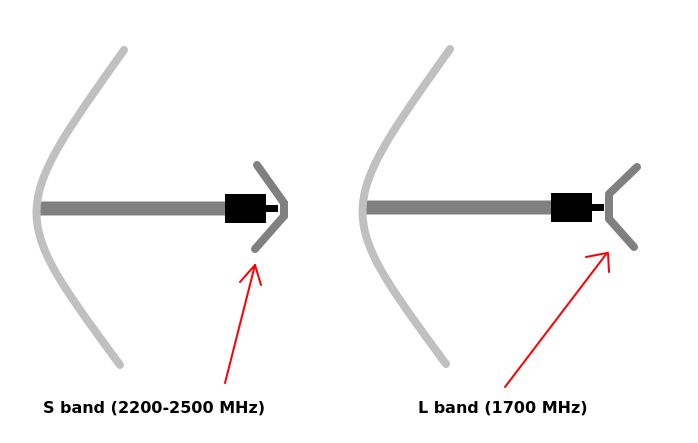
Credit: lego11
- Wi-Fi grid dishes are the best choice for if you want a solution with minimal DIY, however offset dishes are often larger and therefore provide better performance.
- The bigger the dish, the better signal strength you get. It is also more difficult to track with, but on L band it is almost unnoticeable below ~2 M
-
Small dishes cover LEO satellites as well as some geostationary signals just fine, you do not need a big dish to get anything.
-
To get a dish, try checking your local marketplaces, people often give old dishes away all the time after switching to terrestrial TV. Aim for at least 60 cm in height/diameter (offset or PF respectively)
- Do note that reception without a dish is possible, but is discouraged for beginners because of the lower margins it gives.
Feed
If you are using a grid dish for reception, you can skip this heading.
- The dish is only a half of the story though, you will need to DIY the feed yourself - it isn’t difficult but requires a bit of effort.
- Different feeds are used for different satellites due to different polarizations, with these satellites you’ll become familiar with Circular and Linear polarizations. They separate as follows:
- LEO satellites exclusively use the RHCP (Right-hand circular) polarization
- The majority of geostationary satellites use a linear polarization, with one series using RHCP.
- GOES GRB is an outlier in geostationary satellite signals, uses both RHCP and LHCP. The LHCP broadcast is pretty much useless to receive, won’t be mentioned in further polarization warnings.
Warning: Using a dish reflects the circular polarizations, meaning you need to create a LHCP feed to receive RHCP signals!
Popular options for feeds are as follows:
- Circular
- Helical antenna: Very forgiving which makes it recommended for beginners, best for offset dishes.
- Patch feed: Recommended for prime focus dishes.
- Linear
- Cantenna: A very easy to make antenna with decent results on both offset and prime focus dishes.
- Loop feed: A fairly unforgiving but simple feed, you can maximize performance when using a prime focus dish by using this calculator and trying to get your dish’s F/D. (The diameter should be around 11 cm!)
- VE4MA: A very well performing feed, best for prime focus dishes.
- This guide will have instructions on building a helical feed, loop, and a cantenna. Dimensions for a VE4MA are also provided.
- Appropriate tools for all of creating these are a soldering iron and multimeter.
Building a helical feed
Helix dimensions are from Lego’s HRPT guide
The helical antenna is a very good and forgiving circularly polarized feed that works best on offset dishes. It also works with PF dishes albeit at a reduced efficiency.
Materials
You will need the following materials:
- A flat and conductive material that has AT LEAST a 13 cm diameter (i.e. a computer case side panel). A thin paint layer shouldn’t greatly affect signal strength.
-
About a meter of 2.5 mm copper wire. Different diameters are fine, but 2.5 mm is optimal.
- Male panel mount SMA port, preferably insulated - Example
-
Adequately sized screws and nuts for the SMA port’s mounting holes
- If not using a 3d printed scaffold (linked later), a non-conductive material used as a support for the helix
- The ground plane can be either circular or square (13x13 cm). Larger ones (i.e. 17x17 cm) can be used, might have a minor SNR benefit particularly on offset dishes where the larger ground plane doesn’t cover the dish itself.
Parts of a helical antenna
The helical antenna consists of two primary parts:
- Ground plane - The conductive surface the helix is laid upon, acts as a secondary reflector (Where the primary one is the dish itself)
- Helix - The wound copper wire
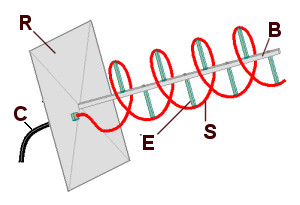
R = Ground plane; C = Coaxial feed; S = Helix; B/E = Supports. Source
Winding the helix
The helix should have these dimensions:
-
Turn spacing: 3 cm
-
Spiral diameter: 5.5 cm
-
Number of turns: 5.5 (3.5 on prime focus dishes)
You have two choices for winding the wire:
- You can wind it manually (Tip: 55 mm PVC pipes are really useful for keeping a consistent diameter)
- 3d print a premade stand and stick a wire through it. Also acts as a support for the wire. If you choose this approach, use the
1700L_5.5T_0.14S_4D_10-90M.stlfile
WARNING!!!
-
This antenna is circularly polarized, meaning you MUST match it to the satellites’ to be able to receive anything!
-
In this case, the satellites transmit a RHCP signal, BUT using a dish reflects it - you have to create a -LHCP- helix!
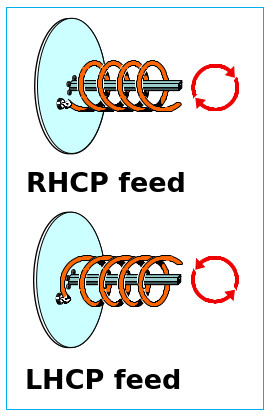
Credit: lego11, source
Putting it all together
- Drill a hole exactly 2.75 cm from the center of the ground plane for the SMA port
- Drill holes matching up with the mounting holes of your SMA port, use screws and nuts to secure it in place
- Install a non-conductive support for the helix in a way that it:
- Can hold the wire up without it swaying
- Makes about a third of the bottom turn run more or less parallel to the ground plane
- Has the bottom end of the wire touching the core of the SMA port
- Solder the helix to the SMA port
- Soldering the wire properly is critical, given that the wire is made out of copper you need to heat the end until it melts solder by itself
- After tin is melting while holding it to the end of the wire and not your soldering iron, move on to heating the SMA core, it should be very easy to solder to.
- Once you applied tin to both the end of the wire and the SMA port, you should be able to heat both at once to get them to bind together
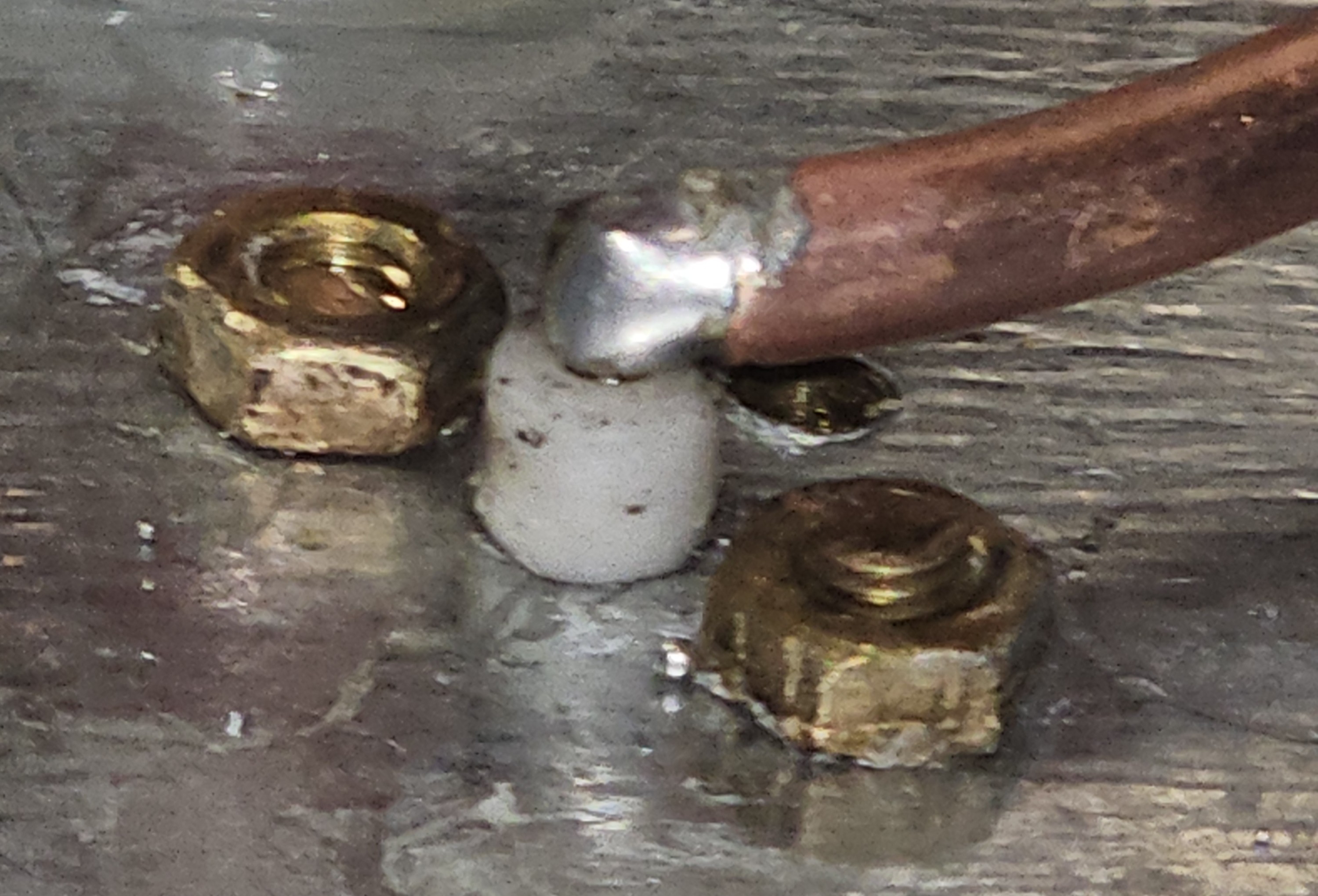 This is how the soldering should look.
This is how the soldering should look.
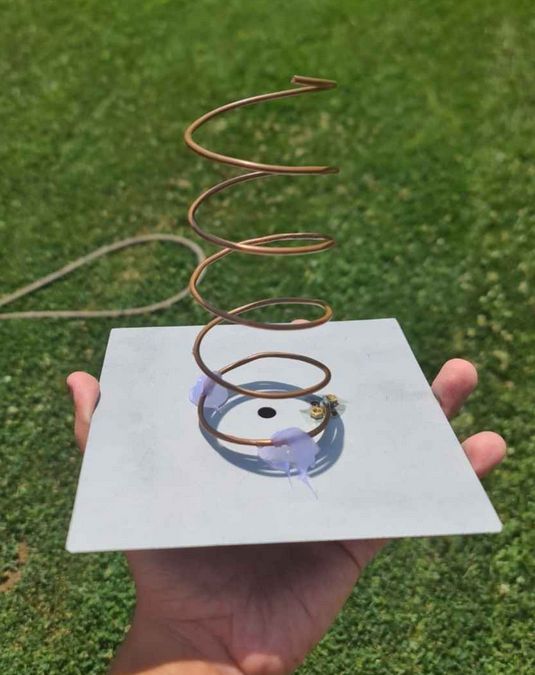
A sample helix, using a gritty zinc spray-painted surface and hot glue as the support. Note how the bottom turn runs mostly parallel to the ground plane.
Congratulations, you now have a helical antenna!
Troubleshooting
If you’re not getting any signals or they’re too weak to decode, it’s wise to check the following using a multimeter before seeking other issues:
- Make sure your polarization is correct! For LEO satellites, when using a dish, the helix must be wound counter-clockwise (LHCP)
- There SHOULD be continuity between the top of the helix and the core of the SMA port
- There SHOULDN’T be continuity between the helix and ground plane, or the frame of the SMA port
If either of these are wrong, verify that your helix is soldered properly and isn’t touching the ground plane or the frame of the SMA port.
Tuning
Note: I still lack experience in this field, take any information about tuning with a grain of salt
If you own a VNA capable of sampling 1.7 GHz, you can tune the helix by:
- Modulating the height of the bottom turn
- Adding a matching strip (example: copper tape)
- Adding a matching wire (solder 1/3 of a turn from the SMA port to the copper wire, see image)
TODO: images
Ideally you want at least a -20 dB S11 return loss at 1690-1700 MHz. However, do note that a poorly made but matched feed will still perform worse than a well-made but unmatched feed!
Building a cantenna
A cantenna is a surprisingly well performing linearly polarized feed for most dishes. It’s very easy to make requiring very little effort, provided you have access to a can of the appropriate dimensions.
Materials
- A can roughly 17 cm in height and 13 cm in diameter
- The height can be lower, but the feed efficiency will be reduced. Assume a 1 cm margin for the diameter.
- Male panel mount SMA port - Example
- Adequately sized screws and nuts for the SMA port’s mounting holes
- A thin piece of copper wire (About 1 mm in diameter. The core of a coaxial cable should do just fine)
Building
- Put the dimensions of your can into this calculator
- For the frequency choose 1700 MHz, your can is suitable as long as 1700 MHz is between the cited TE11 and TM01 frequencies
- Mark and drill the holes for the SMA port according to the calculator
- Remove as much insulation from the probe (antenna) side of the SMA port as possible while still isolating it from the cantenna body
- Solder a wire onto the probe so, that the height of the whole probe (including the part attached to the SMA port) is 44 mm (1/4 wl)
- Secure the SMA port in place by using screws and nuts
Congratulations, you have successfully made a cantenna!
Building a loop feed
Used dimensions are from FelixTRG
!WARNING! - This feed is DC-SHORTED, do NOT connect a bias tee directly to it, it WILL short out!
A loop feed is a moderately difficult to make and also easy to mess up linearly polarized feed which offers decent performance on most dishes. The values used here are for PF dishes with an f/D ratio of about 0.4, but they should work on most other dishes as well. If unsure about your F/D, you can calculate the ratio of your PF dish here and an offset dish here
Please note that the f/D calculation for offset dishes is significantly more complex than for PF dishes, the website I linked should be replaced by a better one if I find one. (TODO)
Materials
- 17.5 cm of copper wire
- Male panel mount SMA port - Example
- Adequately sized screws and nuts for the SMA port’s mounting holes
- A few centimeters of solderable coaxial cable (Shielding has to be solderable)
- Copper-shielded coax, you can not solder aluminum shielded coax.
- Some kind of a non-conductive 21.7 mm long support
For materials, you can either get:
- A can with an 11 cm diameter made out of a conductive material
Or, if you prefer working with raw materials:
- A round conductive plate that has a 10.9 cm diameter
- A 34.5 cm long 22.6 mm tall plate (with a margin for riveting/soldering)
Constructing
- Depending on what materials you used:
- If working with a can, cut so that the rim is 22.6 mm tall from the bottom of the can
- If working with raw materials, solder or rivet the pieces together to create a round plate (10.9 cm diameter) with a 22.6 mm tall rim
- Bend the copper wire into a circle, leave a small gap between the ends
- Drill a hole for the SMA port 2.8 cm away from the center, drill and secure it in place using the flange holes and appropriate mounting screws
- Install the support 2.8 cm away on the opposing side from the SMA port
- Strip just the ends and cut as much coaxial cable as is needed to solder:
- The core of the coaxial cable between the pin on the SMA port to one end of the loop
- The shielding of the coaxial cable between the body of the SMA port and the other end of the loop
- - -
- Make sure to include some margins for the shielding, more doesn’t hurt
- Make sure the uninsulated core run is as short as possible
- When measuring, the loop should be placed on the support and be perpendicular to the ground plane (bottom).
- Solder the coaxial cable
- If using aluminum-shielded coaxial cable, you can wrap one end between the SMA port’s flange screw and its nut; this will spare you having to solder it on one end. Just make sure the nut is real tight.
- Place and secure the other end of the loop on the support, the coaxial cable should secure one side and the support the other. If needed, add a second support on either side.
Congratulations, you have made a loop feed!
Tuning
Note: I still lack experience in this field, take any information about tuning with a grain of salt
- The feed can be tuned by adjusting the gap length and height above the ground plane.
VE4MA feed
This is the best performing linearly polarized feed on larger (>1.2 m) PF dishes. It is fairly difficult to make, but is worth it with the results. I will not describe the individual steps due to the different approaches you can take, but will provide the dimensions adjusted for 1700 MHz below:
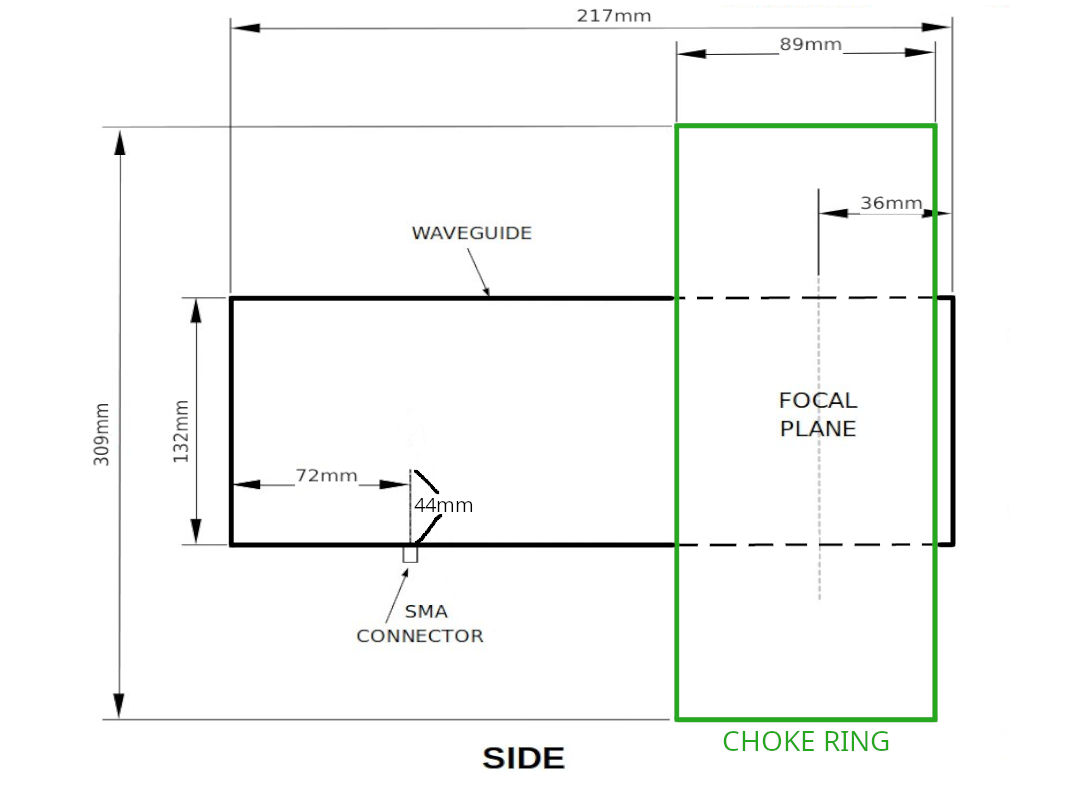 VE4MA feed dimensions adjusted for 1700 MHz. Values calculated by albatross_v2
VE4MA feed dimensions adjusted for 1700 MHz. Values calculated by albatross_v2
Mounting feed to dish
This wholly depends on your dish and its existing mounting solution, is completely up to you to DIY. Anything should be fine as long as you ensure two things:
- The helix front of the feed isn’t covered by anything
- The feed is in the focal point correctly:
- Helix: The focal point should be in the center of the ground plane
- Loop: The focal point should be in the center of the ground plane
- Cantenna: The focal point should be in the mouth of the can
- VE4MA: The focal point should fall on the focal plane (see image)
The focal point is exactly where the front part (mouth) of a TV LNB would be
Drilling small holes into the ground plane shouldn’t greatly affect reception. Personal tip: zip ties are your best friends.
Actually receiving the satellites!
Correctly adjusting your gain
Setting your gain properly is vital, as an incorrect setting can severely hurt your reception capabilities either due to the signal being weaker than it can be, or by saturating your SDR which damages the signal’s quality. Setting your gain beyond the SDR’s saturation point only gives an illusion of a stronger signal, does NOT make it stronger, even if the SNR meter indicates otherwise! You can see this by looking at the constellation while upping the gain pas this point, it deforms but does not grow clearer. Another way of seeing this is by looking at the BER of signals with FEC, it stays the same or even grows higher.
To ensure it’s set correctly, use the Debug menu in SatDump’s Recording tab and refer to the following examples:
1) A lot of dots are hitting the edge OR the dots are forming a square → Gain too high
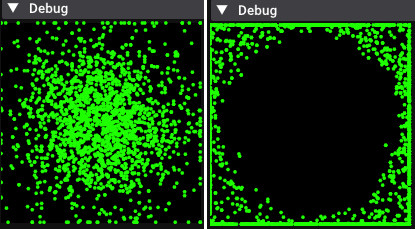
- On the left is what you might see if the gain is set slightly too high, lower it by a few dB.
- On the right is a more extreme example, where the gain is set much higher than needed resulting in the SDR severely overloading. If you see anything like this, the signal you are trying to receive is being significantly hurt by too high gain. You need to lower it by quite a bit.
2) There’s only a small dot or circle in the middle → Gain too low
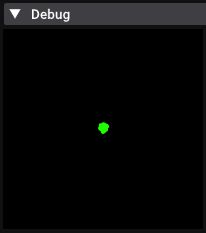
A small dot means that you should up the gain, if you’re already maxed you can leave it as is.
3) A circle is present, the majority of the dots aren’t hitting the edges → Gain just right
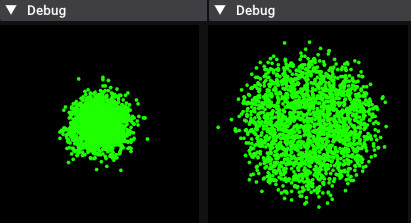
- What you see on the left is ideal gain with no signals on the FFT
- What you see on the right is ideal gain with signals on the FFT
LEO reception
- Get to a place that has LOS for as much of the pass as possible, the longer you can see the satellite for, the longer the resulting image will be
- Try getting clear LOS with the sky, unlike VHF, the signals are attenuated significantly easier. They should still pass through dead trees with ease.
- In the beginning, aim for lower (<60°) passes, as higher ones require some precise movements which you’ll have to learn
- Open SatDump, move to the
Recordingtab, start the appropriate pipeline in theProcessingshortly before the pass- You can optimally select the satellite in the
Trackingtab so you have an easy-to-see reference of where the satellite is in real-time
- You can optimally select the satellite in the
- Aim your dish in the general direction of the satellite, move it around until you can begin seeing the signal
- With Meteor HRPT, you will first see the strong carrier in the center of your FFT
- With MetOp/AWS, you will first see a lot of smaller jumpy lines appearing, which is filler that’s stronger than the actual data payload
- When you see the pipeline sync or the deframer count start ticking up, you’re now getting a signal! Make slight adjustments until you see the SNR counter start ticking up, it should go up fairly quickly thanks to atmospheric phenomena.
- Once you see that you have an SNR reading, only make slight adjustments from this point onward. I personally recommend you SNR track - create a small margin, move your dish very slowly to get the average as high as possible. The general convention for L-band is point & wait - you do not need to be moving constantly, just move when the signal starts getting weaker.
For high (>60°) passes, you will have difficulties tracking the satellite with an offset dish because of the offset - I personally suggest the following steps:
- Track normally until you’re pushing the arm into the ground
- When the signal starts getting weaker, rotate the dish until it comes back to the original strength (or the best strength you can achieve, should be no more than a few dB weaker than the peak)
- WAIT until the signal starts getting weaker again, repeat step 2
- When you’ve rotated 180°, begin tracking as normal again
-
After the satellite sets below the horizon or obstacles, or gets too weak to decode, hit
Stopon the pipeline - The results of your pass will now automatically get processed by SatDump, you can view the progress in the
Offline processingtab. After it finishes, the results are saved to theViewertab.If SatDump crashes, or you shut it down before it could write the results, don’t worry! SatDump automatically writes the raw data to the live output folder during the pass, you can just select the pipeline in the
Offline processingtab` with the .cadu/.raw16 file as the input, cadu/frames as the input level respectively. - You are now done! You can now play around with the results, you can figure it out (:
If you experienced any issues during the pass, make sure to check the common issues heading out!
Geostationary reception
! WARNING ! - The vast majority of geostationary satellites broadcast linearly polarized signals, which require you to match their skew (rotation of your feed) - rotate the feed (or dish) until it’s the strongest. If using a circular feed, you do not necessarily have to do this with Elektro-L and GOES GRB as they are circulrily polarized, however it can still squeeze an extra dB or so out due to real world variations.
-
Aim your dish using whatever broadcast the satellite transmits constantly, or using a dish alignment app (Less accurate). Alternatively, locate the rough area of where the satellite should be in the sky, start the correct pipeline and when the broadcast starts quickly try to find where the signal is the strongest. You usually have a few seconds to find it, which is more than enough in most cases.
-
Open SatDump, move to the
Recordingtab following the same setup as for HRPT -
Start the appropriate pipeline:
Signal Pipeline Elektro LRIT Elektro-L LRIT Elektro HRIT Elektro-L HRIT Elektro GGAK Elektro-L GGAK* GOES HRIT GOES-R HRIT GOES GRB GOES-R GRB GOES GVAR GOES GVAR GOES Imager SD GOES-N Sensor Data GOES Sounder SD GOES-N Sounder SD FengYun 2 S-VISSR FengYun-2 S-VISSR FengYun 4 LRIT FengYun-4[A/B] LRIT FengYun 4 HRIT FengYun-4A HRIT -II/III GEO-KOMPSAT LRIT GK-2A LRIT GEO-KOMPSAT HRIT GK-2A HRIT MSG PGS MSG Raw Data
* In older SatDump versions known as Elektro-L L-band TLM
-
The broadcast will show up as a bump that might occasionally jump up and down, you should be seeing a few decibels of signal,
SYNCEDand green Reed-Solomon numbers when applicable.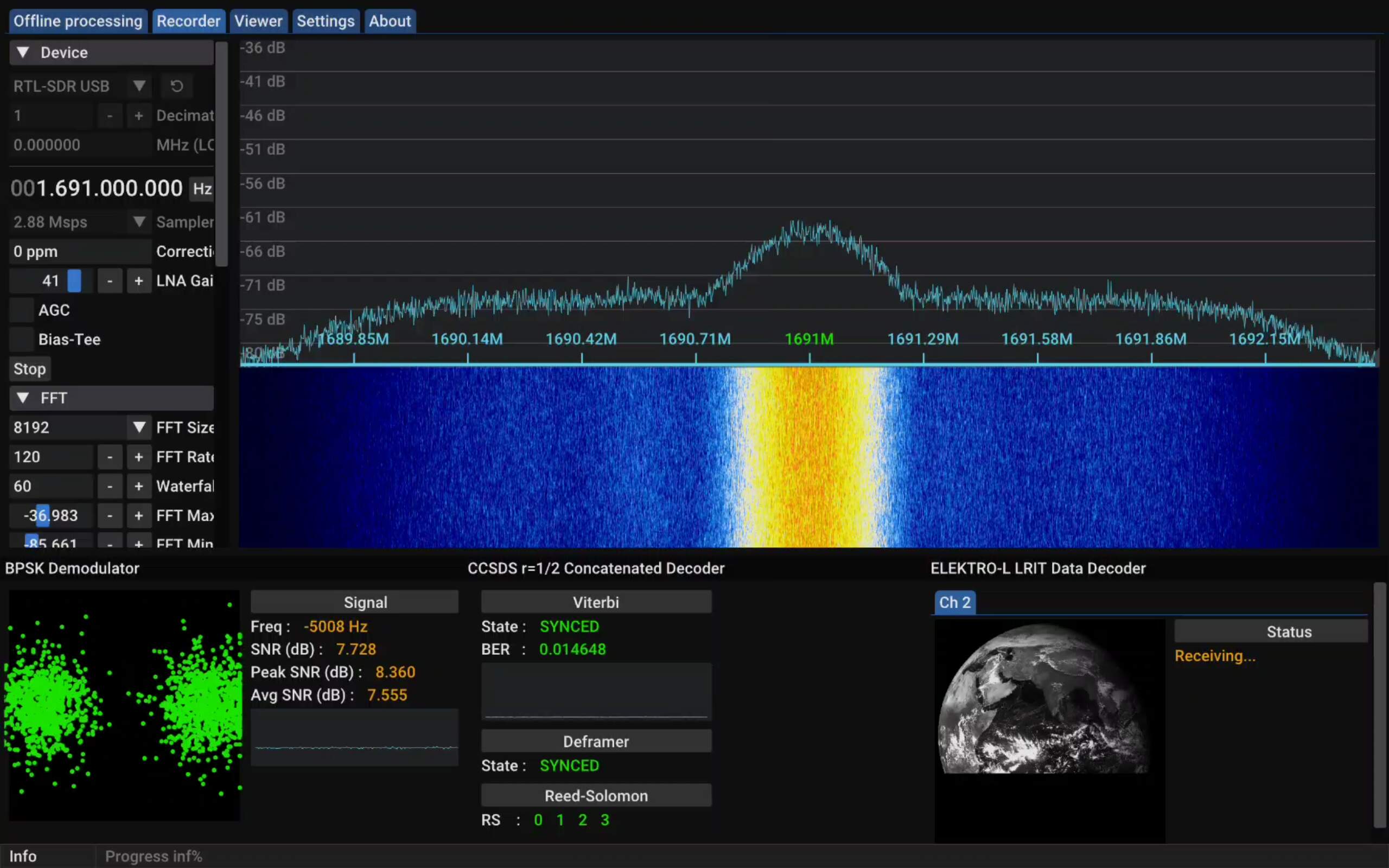 SatDump mid Elektro LRIT reception
SatDump mid Elektro LRIT reception -
After the transmission stops, or you are satisfied with the results, hit
Stopon the pipeline - For most satellites (SatDump 2.0!), SatDump will generate a
products.cborfile which you can load into theExplorertab for processing- For all satellites, navigate to your live output directory, open the folder of the latest live recording. The images will be in the
IMAGESfolder. - On most series, you should also have a
products.cborfile present here that you can load into SatDump’sViewertab.
- For all satellites, navigate to your live output directory, open the folder of the latest live recording. The images will be in the
- You are now done! You can now play around with the results using 3rd party tools or SatDump where applicable.
If you experienced any issues during the pass, make sure to check the common issues heading found below!
Common issues
Noise floor is jumpy/unstable
- This is caused by interference, which can have a few sources:
- A bad USB cable (Spikes all over the spectrum)
- Your phone communicating to a cell tower (Random jumps)
- Proximity to a cell tower (Super strong and wide signals, random jumps)
- Strong thunderstorm close by
- Fixes for each are:
- Use a better USBs cable
- Set your phone to airplane mode
- Move farther away from cell towers
- Wait for the storm to pass, see if the issue persists
Universal solutions:
- Lower your gain until the interference is minimized
- Buy an additional filter, the most popular solution being a Sysmocom cavity filter
TODO: IMAGE
Donut shaped constellation with NOSYNC on the viterbi
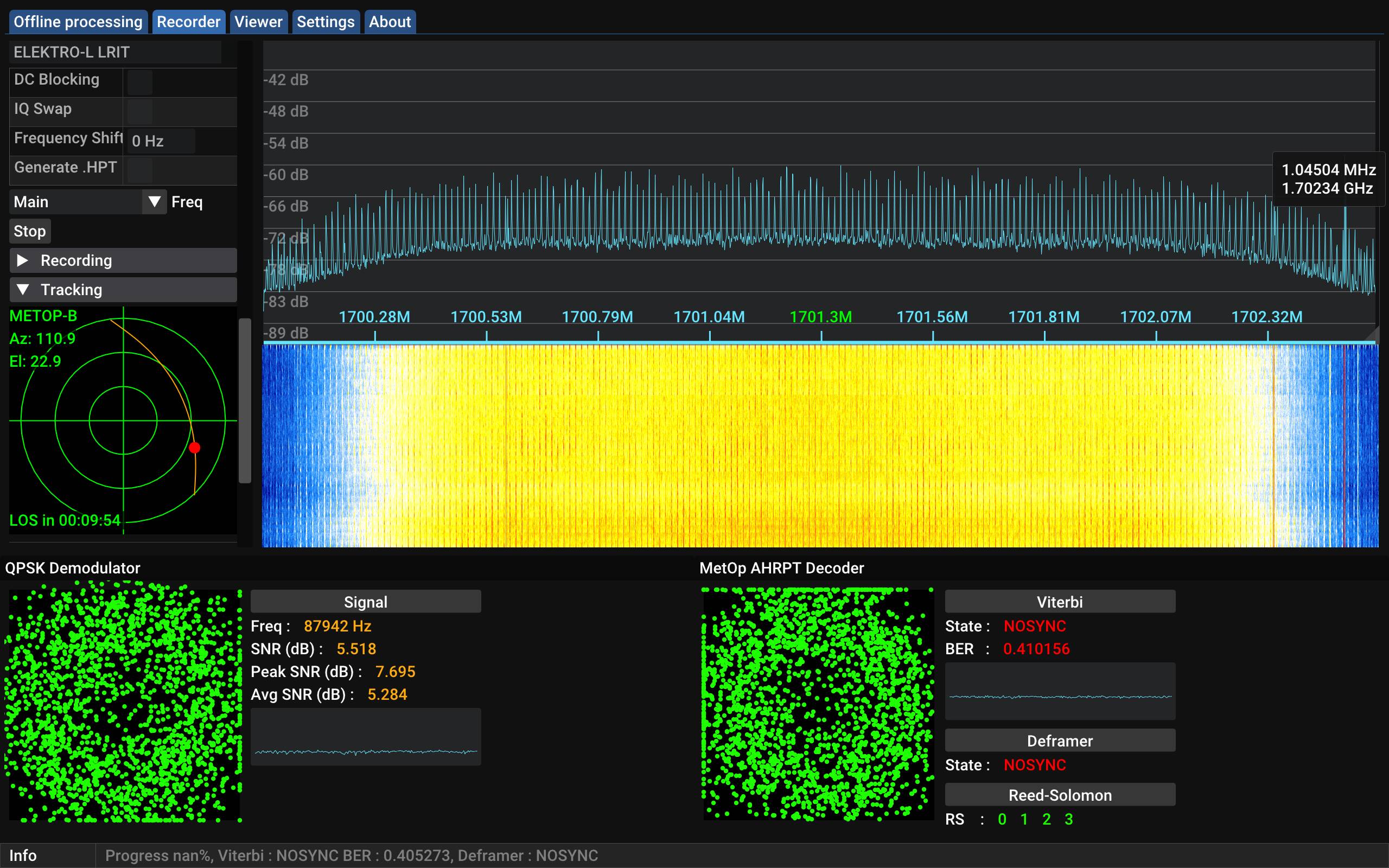 Both demodulators are showing a donut shape instead of the correct QPSK modulation (four dots in each corner).
Both demodulators are showing a donut shape instead of the correct QPSK modulation (four dots in each corner).
When decoding signals with symbol rates close to your sampling rate (Such as MetOp AHRPT on RTLSDRs), you might notice that, even while you’re getting a strong signal, you still have NOSYNC indicated on the viterbi and have a donut shaped constellation on the demodulator. This happens, when the reference for the signal is way out of frequency making the pipeline and in term its demodulator not be able to lock onto it.
To fix this, you have a few options:
- Make sure you are using your SDR’s maximum stable sampling rate
- Shift the frequency around until you manage to lock
- Lower the pipeline’s PLL bandwidth
If you continue to get a donut shaped constellation even after making the adjustments, you’ll need an SDR capable of higher sampling rates.
No/cut up image output with spikes on the viterbi when decoding signals with FEC
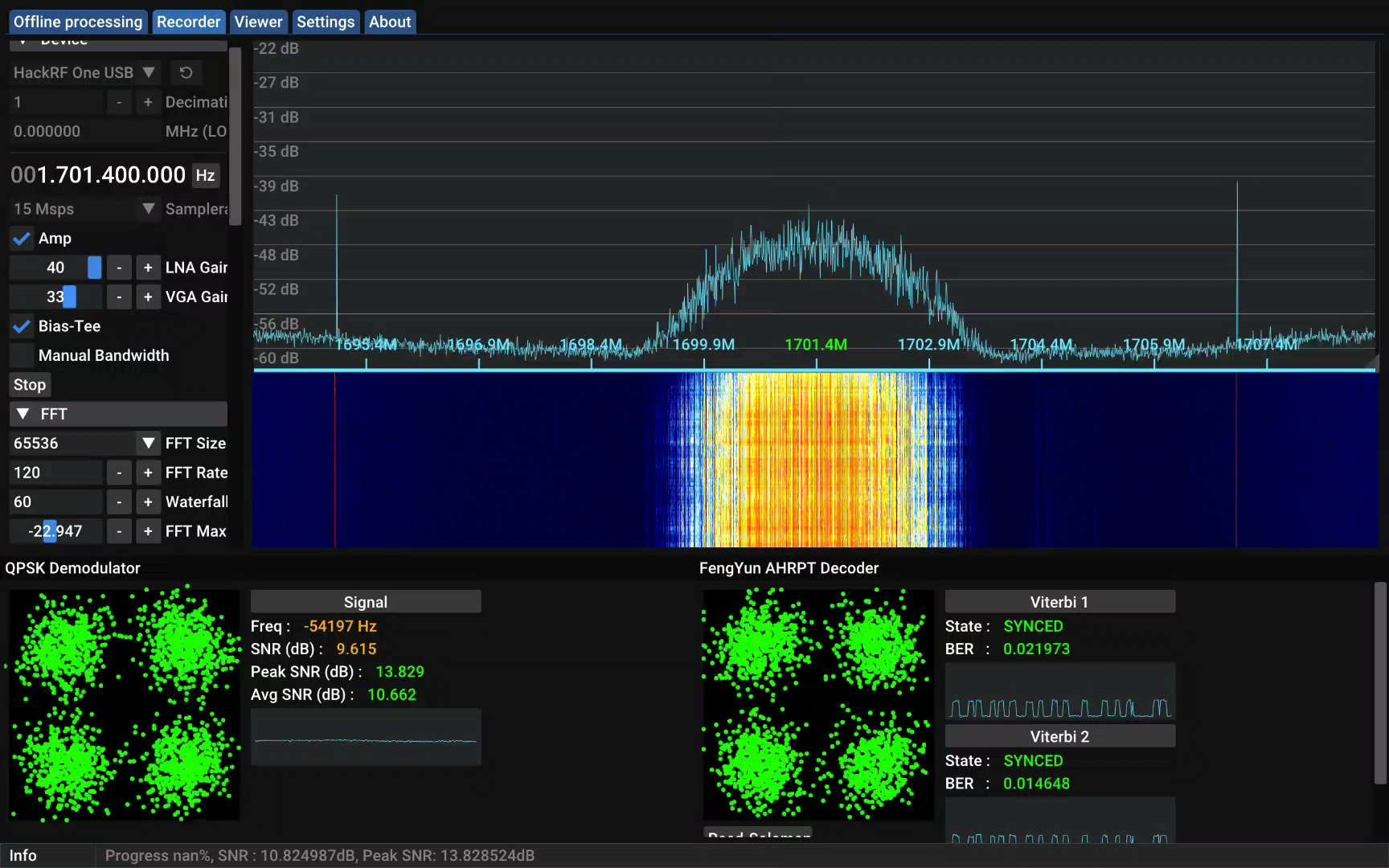 You can see the spikes on the viterbi, on a video you’d see
You can see the spikes on the viterbi, on a video you’d see NOSYNC constantly popping up
This predominantly happens when you are dropping samples, which happens either when your SDR is unable to sample the radio spectrum as quickly as you set it to, or when your computer is too slow to process all samples quickly enough. To fix this, you can try a few things:
- Enable the
High powerpower plan - Set SatDump to the highest priority in your task manager (If possible)
- Disable battery optimization, close other apps/programs
- Lower the sampling rate
If you are still dropping samples after trying these, you might want to try another device, or an OS which isn’t resource heavy such as Linux.
SPS is invalid error when starting pipelines
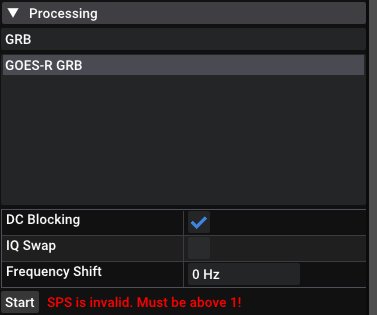
This error appears when your sampling rate is lower than the signals symbol rate. Set your sampling rate to be at least roughly 1.2x the symbol rate (to gain some overhead). If not possible, get an SDR capable of sampling at higher rates or don’t receive this signal at all.
Note that with orbiting satellites you NEED additional overhead due to doppler shifting. With geostationary satellites you can push close to the minimum thanks to the signal not experiencing doppler shifting.
Miscellaneous stuff
Why does LRIT transmit pre-equalized channels?
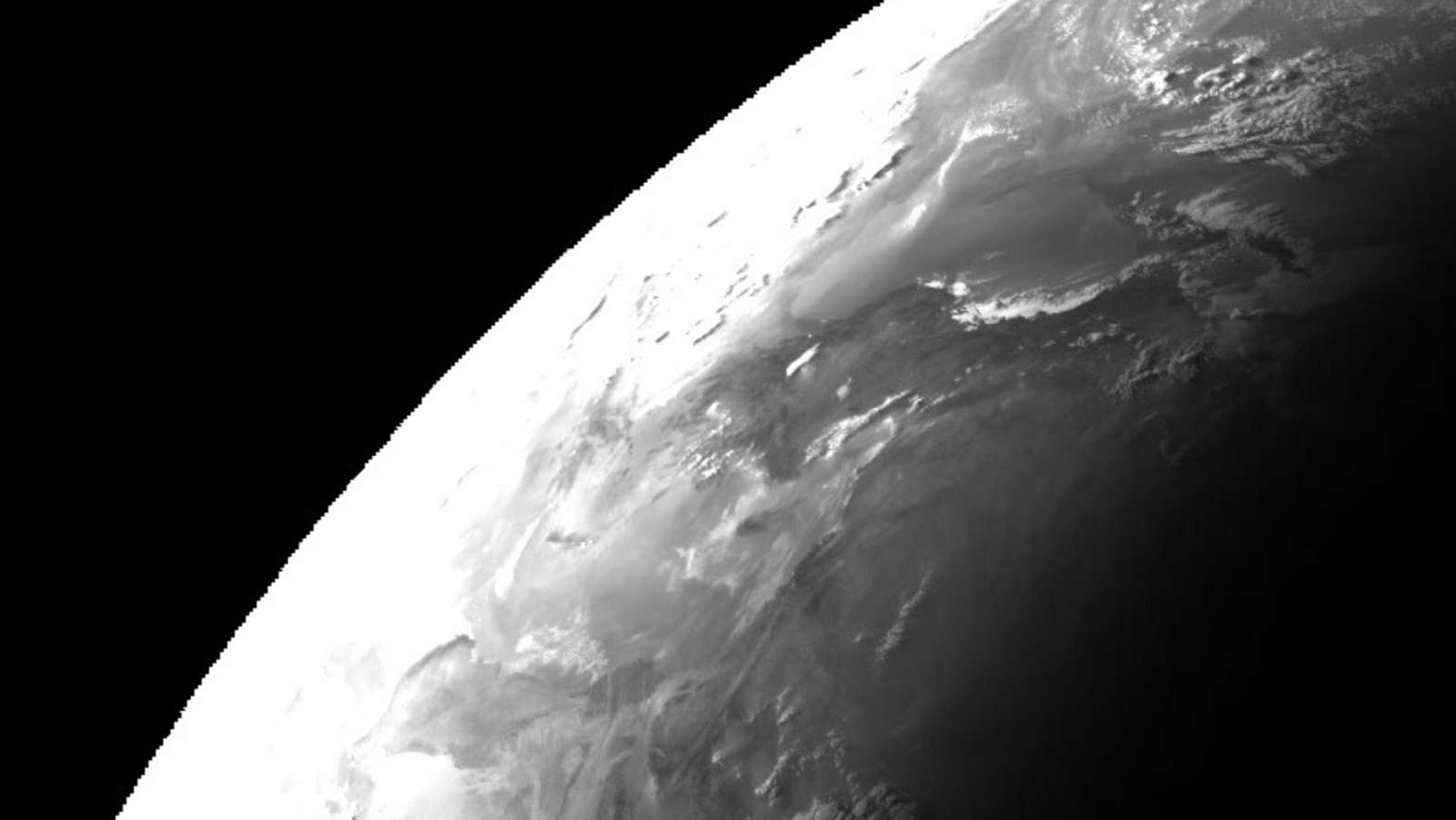 Elektro-L3 channel 1 crop received by yours truly from LRIT on 15/8/2024 at 15:42Z. Lossy JPEG compression with 60% quality applied. Raw image can be found here
Elektro-L3 channel 1 crop received by yours truly from LRIT on 15/8/2024 at 15:42Z. Lossy JPEG compression with 60% quality applied. Raw image can be found here
If you ever received LRIT at a time slot that has a very low illumination, you know the issue very well - the edge of the Earth often turns solid white from overexposure. The reason for this comes from why LRIT exists in the first place - easy data availability.
Remote stations (for Elektros primarily in Siberia) are often made as cheaply as possible, for LRIT specifically they are too weak to do anything besides applying basic LUTs - they would be unable to do image processing themselves, so it is done for them on the satellite level using histogram equalization. While this makes the imagery unusable for more advanced meteorological purposes (since you can’t calibrate an equalized image), it is perfectly usable for public visualizations or TV display.
A question you might have is, whether Roscosmos could just not use a different algorithm depending on the illumination, making the imagery not appear overexposed when fully illuminated. The answer is that they could, they just don’t.
Pass rating scale
This scale is not official or perfect, I just created it to be able to gauge how good each xRPT satellite pass was. Which metric to use is debatable, but I personally prefer how many kilometers of the ground track you received from the satellite. Given most LEO satellites have a spatial resolution of approximately 1 kilometer in this band, you can use the vertical length of raw images to get the amount of kilometers you tracked
For example: /path/to/product/MSU-MR/msu-mr_1.png, has a 2,048 × 4,750 px resolution. This means, that the resulting image has approximately 4,750 km of the satellite’s ground track.
| Kilometers tracked | Pass quality |
|---|---|
| <250 | Very poor |
| 250-1000 | Poor |
| 1000-2000 | Okay |
| 2000-3000 | Good |
| 3000-4000 | Very good |
| 4000-5000 | Excellent |
| 5000-5500 | Almost perfect |
| >5500 | Perfect |
The theoretical limit for this is around 6000 km, which has been received by some by using atmospheric phenomena to receive the satellite even just below the horizon.
Changing the PLL bandwidth
Changing the PLL bandwidth makes a signal easier/harder to lock on to, can help with situations such as:
- Reception with low SNR
- Reception of signals with insufficient sampling rates (<2 times the symbol rate)
To change it:
- Open SatDump, enable
Core settings>User interface>Advanced mode - Press
Saveon the bottom of your page,Advanced settingsshould now pop up - Navigate through
Default pipeline configs><Target-pipeline-name>>Work>Soft>psk_demod - Adjust the
pll_bwoption as needed - Press
Saveto save the modified value, you can disable the advanced mode afterwards
In case of MetOp AHRPT reception with RTLSDRs you should adjust set the PLL bandwidth to 0.002.
Minimum SNR for a good decode
If the signal lacks FEC, you can expect grain when near the minimum SNR.
Note: A good decode is defined as recognizable imagery if no FEC is present, or minimum for a consistent deframer sync with signals that feature it.
| Signal | Minimum SNR | FEC |
|---|---|---|
| Meteor-M HRPT | 0.5 dB | No |
| MetOp AHRPT | 4 dB | Yes |
| Elektro-L LRIT | 2dB | Yes |
| Elektro-L HRIT | 3dB | Yes |
| Goes GVAR | 1.5 dB* | No |
| GOES GRB | 8 dB | Yes |
| GOES HRIT | 4 dB | Yes |
| FengYun 2 S-VISSR | 1 dB* | No |
| FengYun 4 LRIT | 2 dB | Yes |
| FengYun 4 HRIT | 4 dB | Yes |
| GEO-KOMPSAT LRIT | 1 dB | Yes |
| GEO-KOMPSAT HRIT | 4 dB | Yes |
* Using SatDump 2.0.0. Only with the respective correctors and an additional 2 dB otherwise.
Epilogue
-
Sitting just above L-band is the S-band which has some interesting things to receive as well! It requires some different strategies for reception due to amplifiers being difficult to come by and a lot of popular dongles only going up to 1.7 GHz, with the most popular method being modding an MMDS downconverter to be possible to screw it onto a helix. This band contains some university satellites as well as sun imagery thanks to PROBA-2 and Hinode.
- Another interesting and not very hard to receive band to look at is the C-band which offers several rebroadcasts that contain combined data from various satellites. The most notable ones are GeoNetCast, EuMetCast Africa (Receivable in Europe as well), and HimawariCast.
Please note that I call this band ‘easy’ because C-band LNBs paired with appropriately sized dishes are commercially available and very easily sourcable in English-speaking countries. Places where C-band TV wasn’t widely adapted will have a significantly harder time receiving this band.
- If you’re in for easy reception, the road ends here for the time being. BUT if you:
- Have a lot of fundamental radio knowledge,
- Have a lot of time and money available,
- Are not afraid to fall flat on your face several times,
Are insane,
you might be interested in the X-band! It requires incomparably more dedication and effort to receive, but offers pretty much infinite possibilities - it’s what the industry uses right now! With this band, the .5 km/px quality is prevalent, but you can expect imagery with a quality as high as 60 m/px with Meteor-M KMSS! (just an example, other satellites can reach significantly higher resolutions).
Further reading
Contacts
If you have any questions or remarks regarding this page, feel free to message me either on Twitter (@Meti172172), or on Discord (@cpt_dingus).
I hope you had fun reading this article, now go get some pretty pictures!